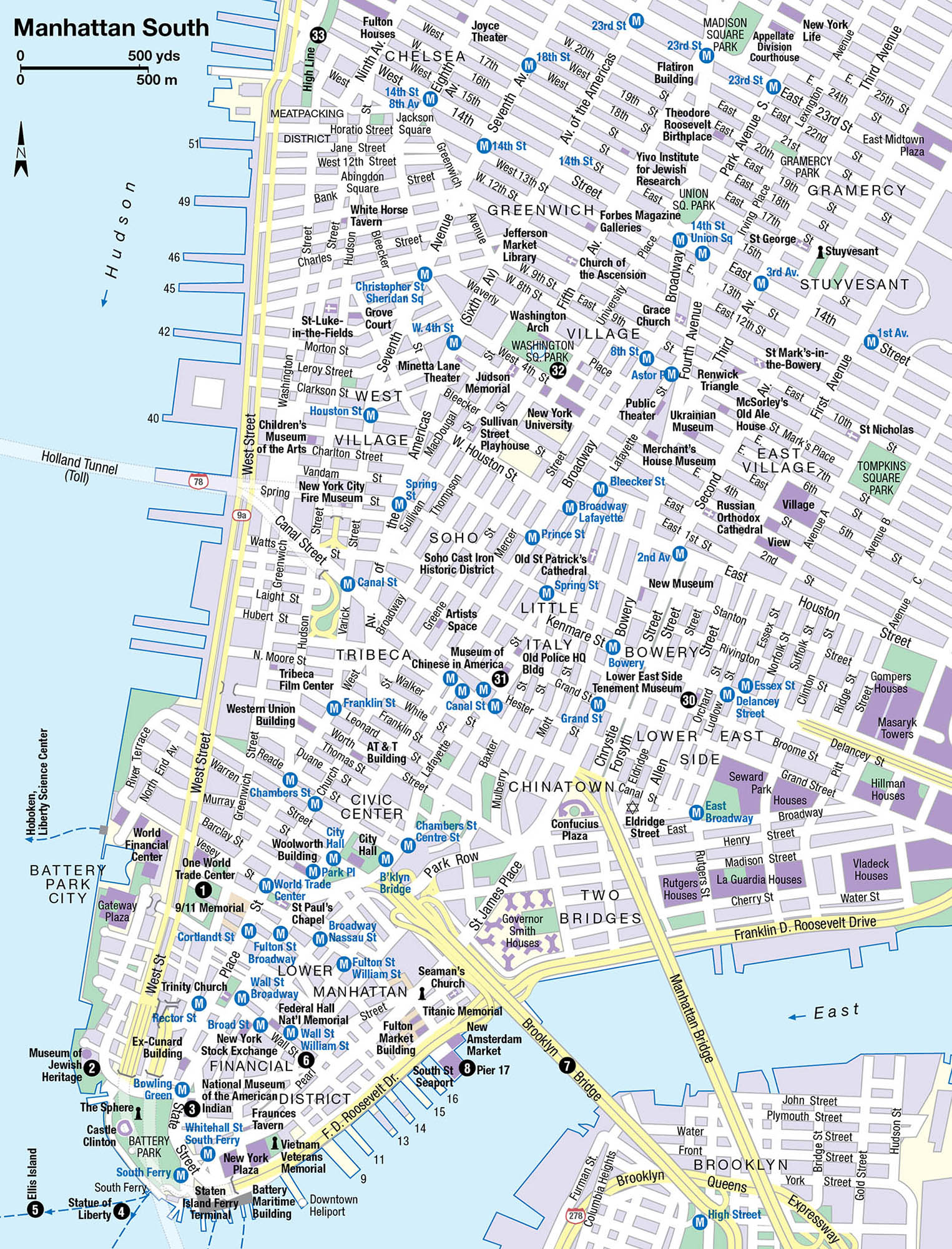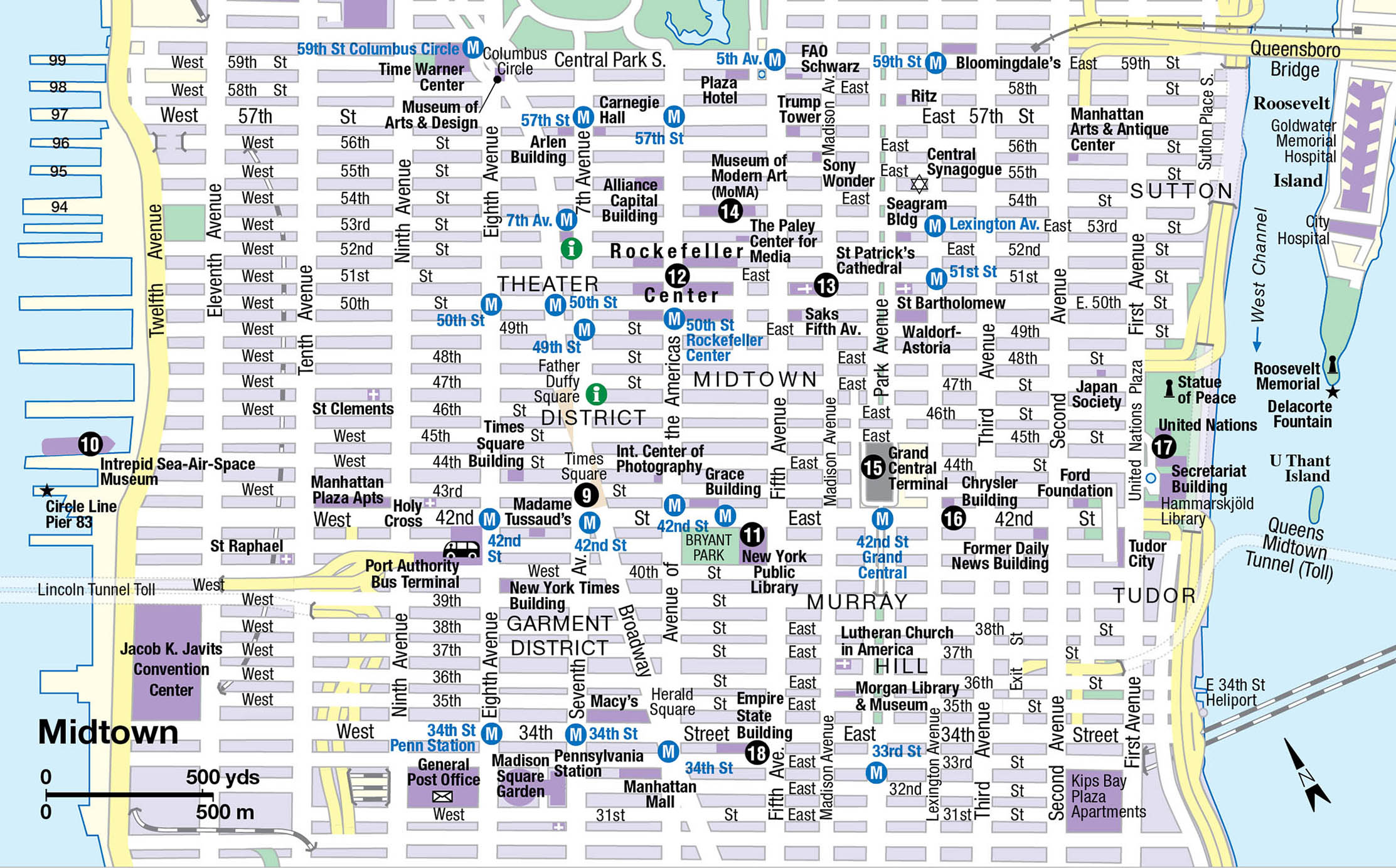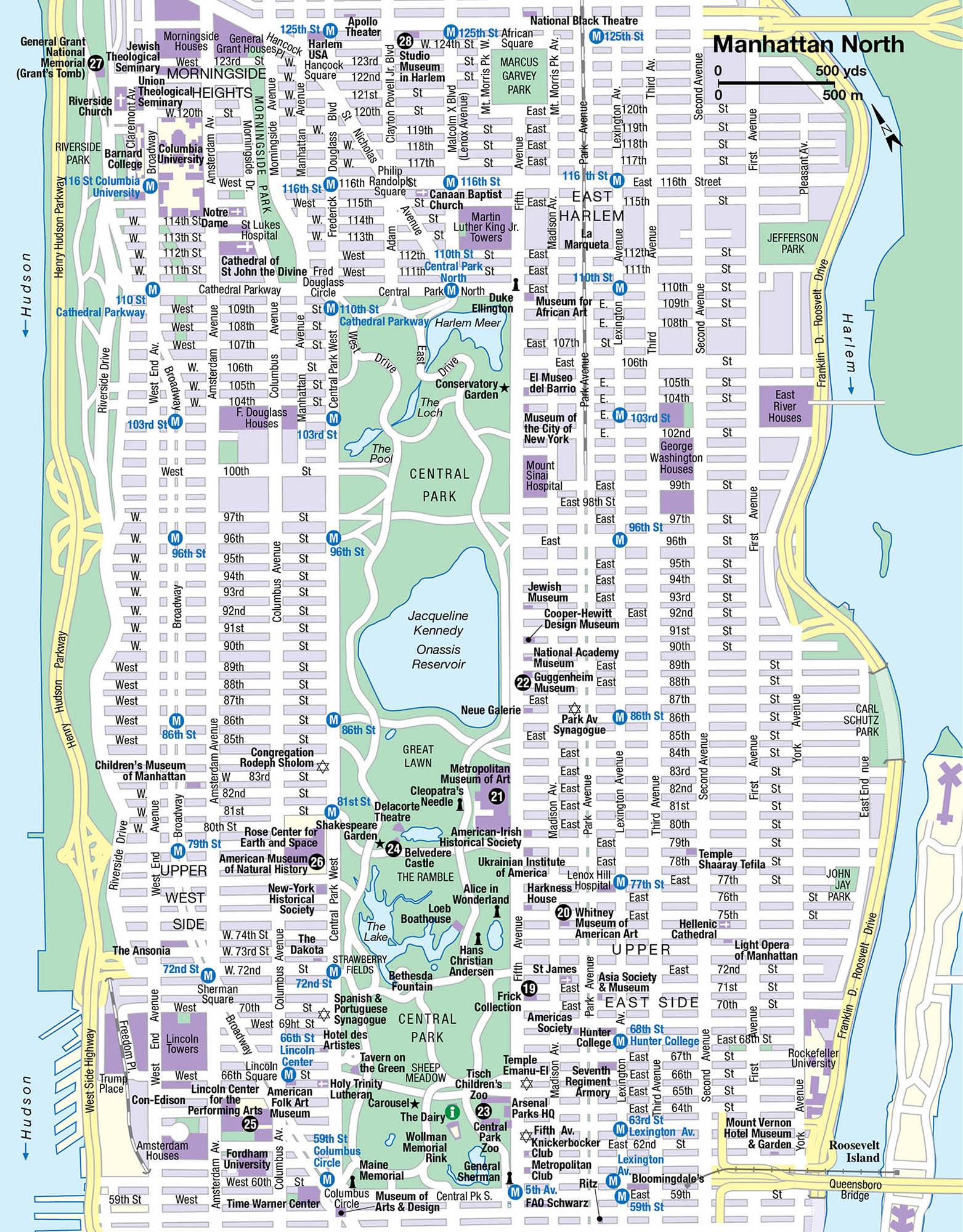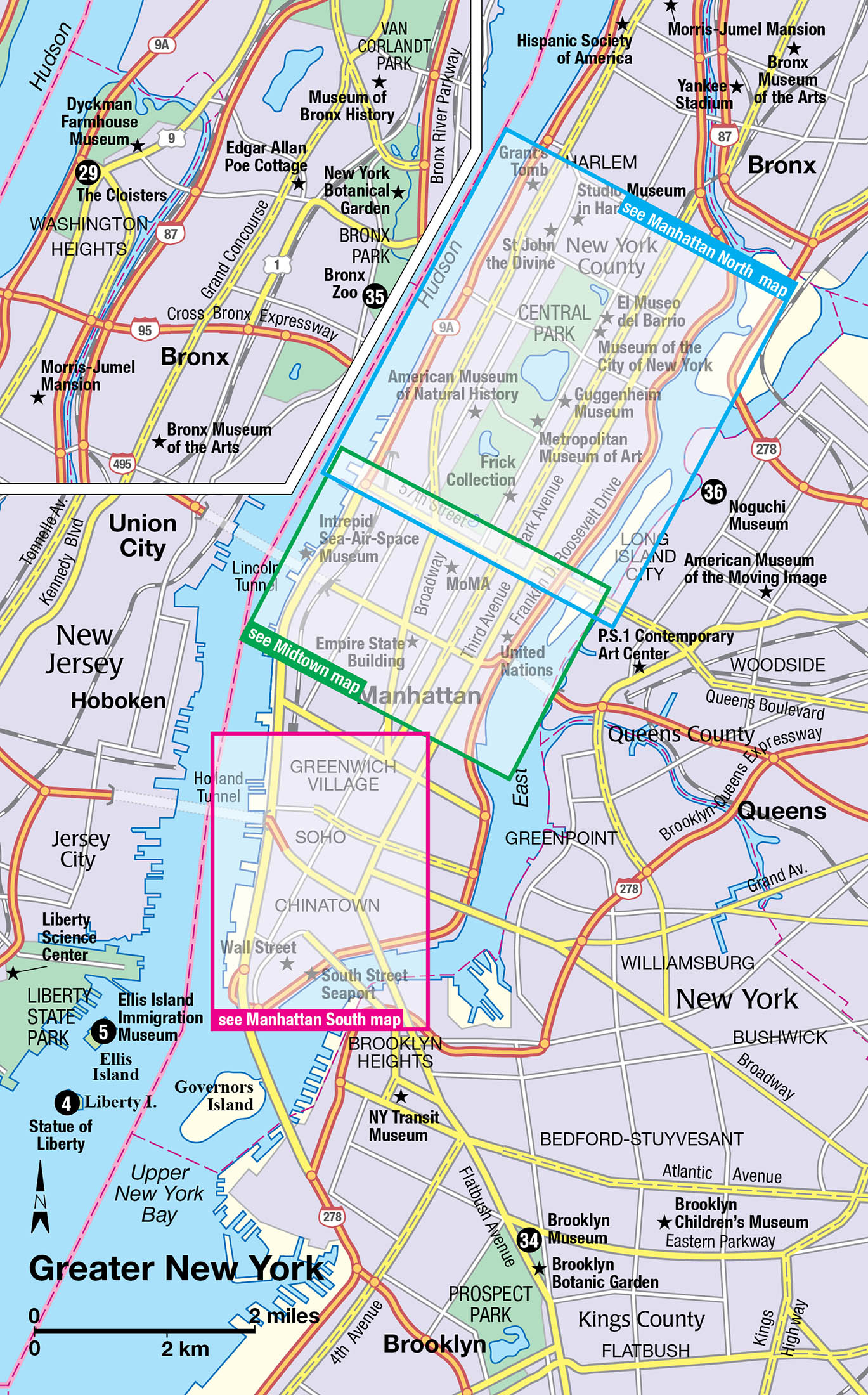While the majority of visitors to New York never leave Manhattan, there is more to the city than its most famous borough. Those who venture to Brooklyn, for example, will find a world-class art museum along with parks, gardens, and fascinating ethnic neighborhoods. One of the country’s great zoos is located in the Bronx, near an equally notable attraction, the New York Botanical Garden. In Queens you will find a top-notch filmmaking museum. Meanwhile, the journey to Staten Island is that borough’s highlight, a ferry ride right by the Statue of Liberty, and best of all, it is free.

Morning view over the Manhattan skyline
iStockphoto
However, Manhattan is the focus of most visitors’ attentions, with its wealth of sights and activities. Only 13.5 miles (22km) long and 2 miles (3.5km) wide, New York’s most popular borough is what everyone calls ‘the city.’ Getting your bearings in this metropolis is remarkably easy thanks to the grid system. Apart from Lower Manhattan – where the thoroughfares twist, turn, and usually have names instead of numbers – all roads running from west to east are called ‘streets’ and those running from north to south are called ‘avenues’. Streets are numbered from south to north and avenues from east to west. Some avenues also have names, such as York Avenue, Lexington Avenue, Park Avenue and Madison Avenue (street signs and addresses list Sixth Avenue as Avenue of the Americas, but New Yorkers rarely call it that). Inclusion of ‘West’ (W) or ‘East’ (E) in addresses shows whether it lies west or east of Fifth Avenue. There is just one avenue that doesn’t conform to this pattern: Broadway cuts acoss the island diagonally.
Downtown
In Lower Manhattan, at the island’s southern tip, is the oldest, most historic part of the city; the Financial District corresponds roughly to the area south of Worth Street, which begins just below Chinatown. Here you’ll find Wall Street, One World Trade Center, the 9/11 Memorial, South Street Seaport, and ferries to Staten Island and the Statue of Liberty. After years of neglect, clubs and bars moved in, making the area worth a visit even after 7pm. A good source of information on developments in Lower Manhattan is the Alliance for Downtown New York, Inc. at www.downtownny.com.
Icon of hope
Remarkable as it might seem, a huge globe-shaped metal sculpture survived the tons of metal and concrete that crashed down upon it on 9/11. The Sphere by Fritz Koenig had stood for more than 30 years in the World Trade Center Plaza. In March 2002, it was moved to nearby Battery Park where it stands at the foot of a bed of roses called Hope Garden. On the first anniversary of the attack, an eternal flame was lit here, in memory of the victims.
One World Trade Center and 9/11 Memorial
For decades, the most visible tourist attraction in Lower Manhattan was the World Trade Center 1 [map]. It was a huge complex of offices, a hotel, shopping malls, subway stations and the twin towers themselves, crowned by the Windows on the World restaurant and an Observation Deck. When the towers were opened in 1970, they were the tallest buildings in the world.
After September 11, 2001 – when the towers became the target of the country’s worst terrorist attack – the construction site where the complex once stood became a moving memorial. It now holds as much, if not more meaning for visitors, as when they came to marvel at the buildings themselves. Today, the shimmering One World Trade Center rises up at the center of the site, and the surrounding 9/11 Memorial offers a tranquil place to reflect and honor the victims.
Architect Daniel Libeskind drew up a masterplan for the site’s redevelopment. On July 4, 2004 the ground was broken on the plan’s focal point, the 1,776ft (541 meter) torqued skyscraper designed by David M. Childs. Acclaimed Spanish architect Santiago Calatrava’s design was chosen for the transportation hub, which is still under construction. The memorial, which incorporates the footprints of the twin towers into its design, was dedicated on the 10th anniversary of the attack. Visitors to the memorial, and its accompanying museum, need to reserve a pass, which is free, from www.911memorial.org.
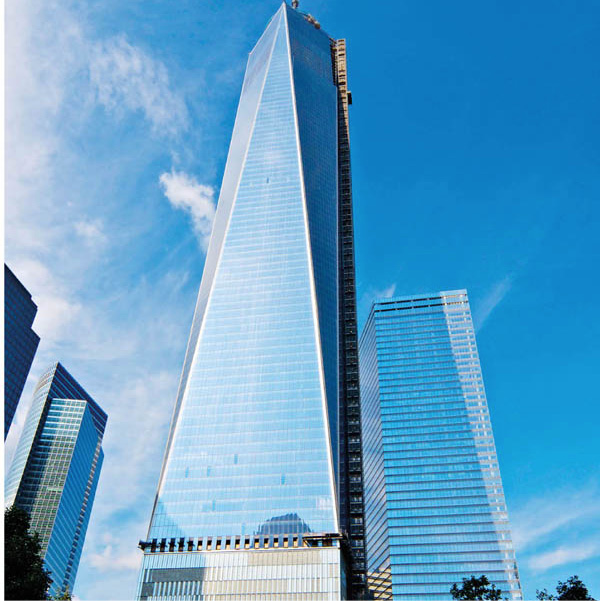
Risen from the ashes: One World Trade Center
iStockphoto
Battery Park City
When the World Trade Center was being built in the late 1960s, some 30 million tons of excavated landfill were dumped on adjoining Hudson River docks to create the site of what became, in the 1980s, Battery Park City, a collection of high- and low-rise apartment and office buildings and parks. A lovely esplanade lined with parks and gardens stretches along the river from Stuyvesant High School on the north end, all the way south to historic Battery Park.
The highlight of the World Financial Center is the fine Winter Garden, a public atrium ringed by shops, restaurants, and bars. Grab take-out from a café and join the stockbrokers on one of the benches, or enjoy a more upscale lunch at one of the sit-down restaurants.

Castle Clinton
Britta Jaschinski/Apa Publications
A stroll down the promenade is a pleasant way to spend an hour, and also a great place to view the sunset. At the end of the promenade, near Bowling Green subway station, is the Museum of Jewish Heritage 2 [map] (www.mjhnyc.org; Sun–Tue and Thur 10am–5.45pm, Wed 10am–8pm, Fri 10am–3pm, closed Sat and Jewish holidays; charge). Beyond the first floor’s interesting multimedia introductory show are galleries about Jewish life and culture; the second floor is devoted to the Holocaust, while the third floor contains exhibits about Judaism today. By focusing on the complexity of Jewish life in the 20th century, the museum give a less harrowing account than others devoted solely to the Holocaust.
Nearby is Battery Park, a leafy expanse at the tip of Manhattan. Most visitors head for Castle Clinton. Originally the West Battery – a fortification to help protect ships in New York from the English navy – the building dates to 1811. By 1824 its military mission was fulfilled and the fort became a concert hall, immigration checkpoint, and even for a while, the New York City Aquarium. The National Park Service took over the building in the 1940s and renamed it Castle Clinton. It was re-opened in 1975 as a small museum and as the ticket office for ferries to the Statue of Liberty and Ellis Island (for more information, click here).
Across from Battery Park’s northern tip, at the foot of Broadway, is a small triangular patch called Bowling Green. It is said that this is where in 1626, Peter Minuit bought Manhattan from Native Americans for the equivalent of $24. Today it is the site of one New York’s many Greenmarkets, selling fresh local produce (Tue and Thur 8am–5pm).
Liberty Science Center
From the docks outside the World Financial Center, you can take the New York Waterway Ferry to Colgate Ferry Terminal (Paulus Hook) in New Jersey (www.nywaterway.com; every 7–8 minutes on weekdays) to connect to the Hudson-Bergen Light Rail (Essex Street Station to Liberty State Park Station; www.njtransit.com) for the Liberty Science Center (www.lsc.org; Oct–June Mon–Fri 9am–4pm, Sat–Sun until 5pm; July–Sept daily 9am–5pm, charge). Though not technically a New York City attraction, is nevertheless a fun place to explore. The exhibitions are designed to appeal to all ages and include a skyscraper area, where visitors can walk along a beam above the exhibition floor and see beams recovered from the World Trade Center. The center also includes an imax theater.
Looming over the square is the Old Customs House, which is now the home of the National Museum of the American Indian 3 [map] (www.nmai.si.edu; daily 10am–5pm, Thur to 8pm; free), a branch of the Smithsonian Institution in Washington, DC. The museum celebrates Native American culture and showcases a variety of artifacts. The other Smithsonian branch in NYC is the Cooper-Hewitt, recently reopened after renovation on the Upper East Side.
Staten Island Ferry
If you are on a tight budget, a ride on the free Staten Island Ferry is a great way to get a closer look at the Statue of Liberty. There is little of interest to visitors on Staten Island, but the 20-minute ferry ride is well worth the trip. Catch the ferry from the southern tip of Battery Park and you’ll get stunning views of the Statue of Liberty and the Manhattan skyline, and since the ferry runs 24 hours a day, you can get the same view at night.
Statue of Liberty and Ellis Island
Ferries for the Statue of Liberty and Ellis Island leave from Battery Park, calling first at the Statue of Liberty (www.statuecruises.com; daily 8.30am–4.30pm in summer, until 3.30pm in winter; departures every 20 mins).
The Statue of Liberty 4 [map] is the most recognized icon of New York City. Some 10 years in the making, it was a gift from France in recognition of the friendship between the two countries and has served as a beacon for immigrants arriving in the New World for over 100 years. Frédéric-Auguste Bartholdi’s 151ft (46m) tall creation is one of those wild dreams that became reality. Engineering expertise had to be harnessed to art, so Bartholdi called in Gustave Eiffel to work on the complex skeletal framework. Parisian workmen erected the statue in 1884, as bemused Parisians watched her crowned head rise above their rooftops. It was later dismantled and shipped in 214 huge wooden crates for re-assembly on Liberty Island. The statue of Liberty Enlightening the World was unveiled by President Cleveland on October 28, 1886.
There are three options for visiting the monument and all must be booked through Statue Cruises (www.statuecruises.com). A basic cruise ticket will get you to Liberty Island, but you will need one of two additional tickets to enter the statue. Most choose a pedestal ticket, which grants access to the base and its museum. A few hundred daily crown tickets are available for those who plan ahead and are able to climb the steep steps to the top of the crown. Please note that many restrictions apply to crown tickets, including minimum height requirements.
Once you arrive on Liberty Island you can learn about the history of the statue with free tours led by Park Rangers. Inside the lobby, visitors can view the original torch, the Statue of Liberty exhibit, then proceed to the promenade area for an up-close view of the statue and a spectacular view of New York Harbor. It is a strenuous climb up the 377 narrow steps to the crown but if you’re lucky enough to snag a ticket, you’ll be rewarded with a great view. The torch remains closed to the public as it has been since 1916.
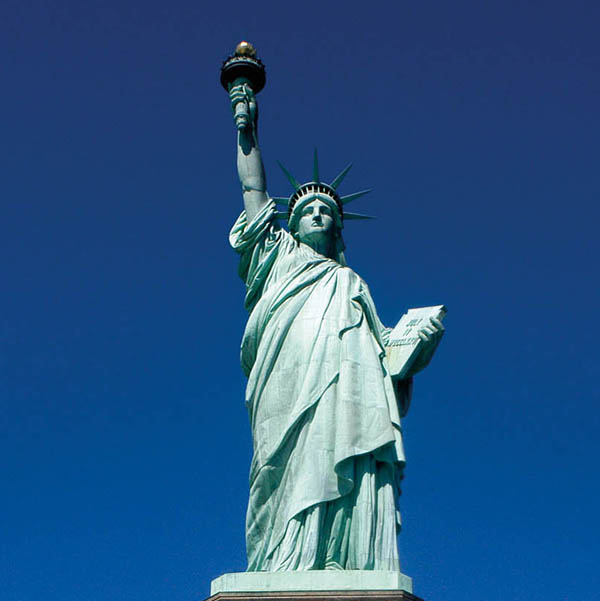
The Statue of Liberty
Britta Jaschinski/Apa Publications
After the statue, the ferry continues to Ellis Island 5 [map]. The island itself was mostly created from landfill from the building of the New York subway system. The museum, which opened in 1990, retraces, through film, audio-visual displays, and exhibitions, the sufferings and joys of some 12 million immigrants who entered the United States through these doors between 1892 and 1954, when overseas consulates took over the screening process. You might find a long lost family member on the Immigrant Wall of Honor. Among notable personalities who made it through Ellis Island were actors Charlie Chaplin, Claudette Colbert, and Bob Hope, composer Irving Berlin, the Von Trapp family of The Sound of Music fame, and author Rudyard Kipling.
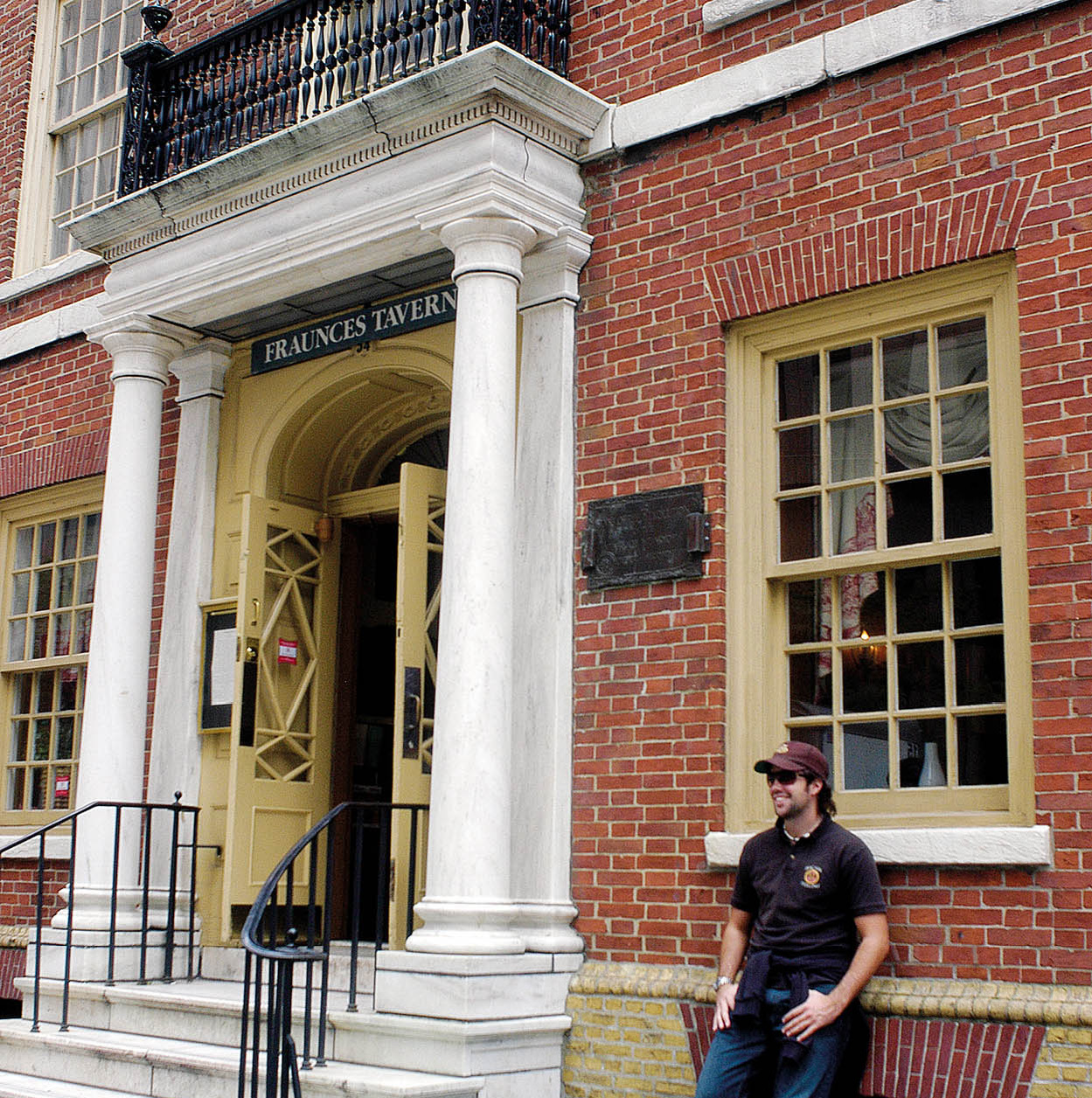
Fraunces Tavern
Britta Jaschinski/Apa Publications
Fraunces Tavern
Near the ferry terminal, at 54 Pearl Street (at Broad Street) is Fraunces Tavern. First opened for business in 1762 (the original building dated to 1719), this is where George Washington is said to have bid farewell to his officers after the Revolutionary War. The building you see today is mostly a recreation, built in 1907. Colonial history buffs may appreciate the modest museum upstairs (frauncestavernmuseum.org; daily 12–5pm; charge): exhibits include documents and period furniture, as well as items such as a lock of Washington’s hair, a fragment of one of his teeth, and a shoe that belonged to his wife, Martha. Others may opt to dine in the pseudo-colonial atmosphere of the restaurant downstairs, together with bankers and brokers (Mon–Fri 11am–9pm, Sat–Sun 11am–4pm).
The immediate area is absolutely teeming with remnants of old New York. After leaving Fraunces Tavern, if you walk to the right on Pearl Street and turn left at the next corner, you’ll come to Stone Street, another historic district with a colonial street plan and buildings that were formerly dry goods warehouses and stores. At the other end of Stone Street, after a quick jog to the right, you will be back on Pearl Street and Hanover Square, which was a wealthy neighborhood during colonial days. Two blocks south of the tavern, at the end of Broad Street, you will find the southern tip of the island and the terminal for the ferries to Staten Island and Governor’s Island (www.govisland.com; weekends late-May–late-Sept).
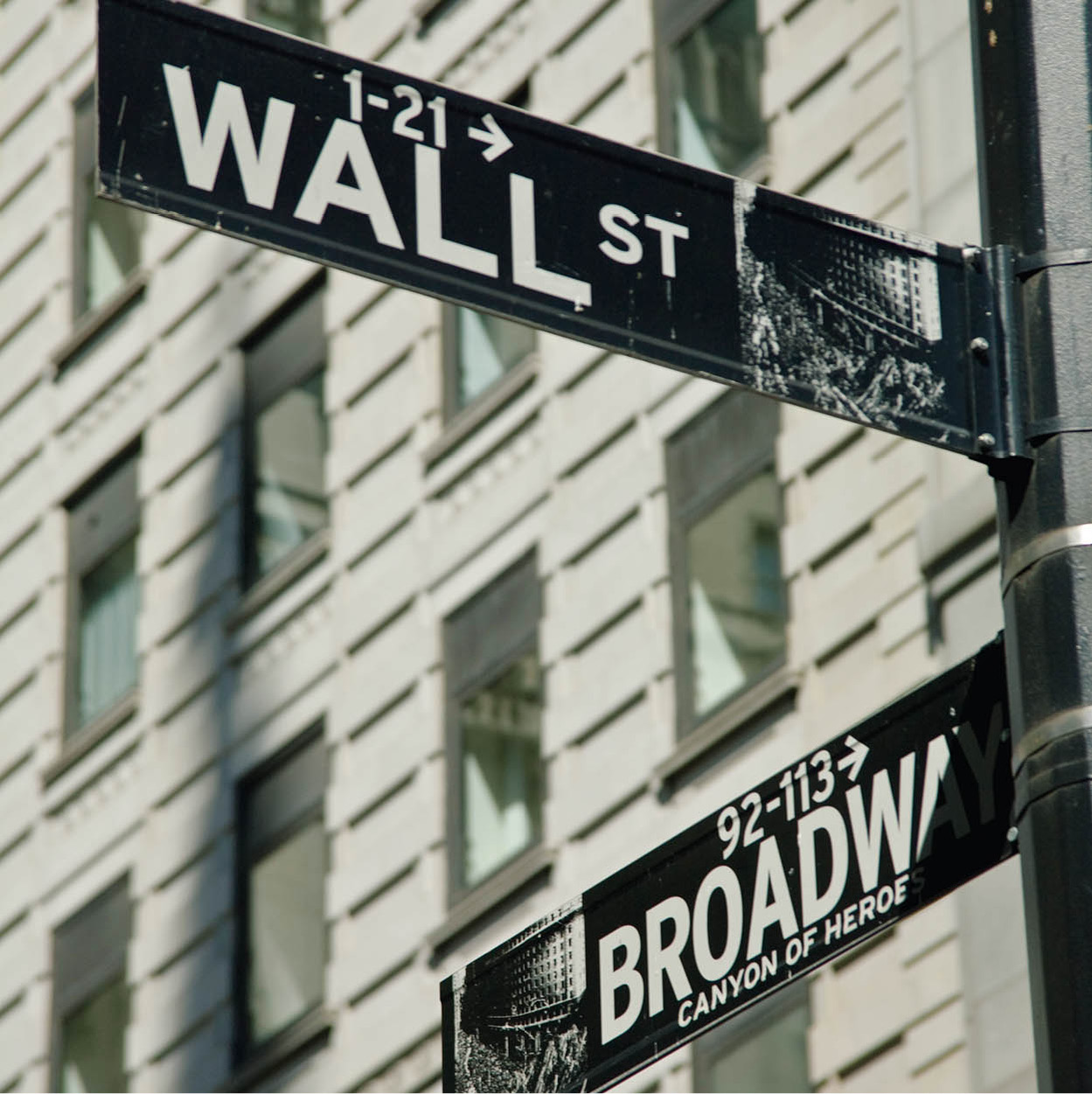
Wall Street
Richard Nowitz/Apa Publications
Wall Street
If you continue on Pearl Street, after a couple of blocks you will come to Wall Street 6 [map], perhaps one of the most famous streets in the world, if only for its metaphoric heft. There was once an actual wall here, built in 1653 by Dutch governor Peter Stuyvesant to protect New Amsterdam from the encroaching British. Turn left on Wall Street to find several buildings of note. Number 55 Wall Street, which dates to 1842, is one of the oldest buildings on the street. The tallest, at 927ft (283m), is 40 Wall Street. Now known as the Trump Building, this was briefly the world’s tallest structure, before it was eclipsed by the Chrysler Building’s spire. The skyscrapers here are closer together than at any other place in the city, leading locals to dub them the ‘canyons’ of Lower Manhattan.
At 26 Wall Street (at Nassau), you will see a large statue of Washington outside Federal Hall National Memorial (www.nps.gov/feha; Mon–Fri 9am–5pm), which was formerly the US Customs building. The original building, demolished in 1812, was the home of the US government for a year when New York was briefly the nation’s capital (1785–90); it was also where Washington took the oath as the first president of the US, on April 30, 1789.
Most visitors to the city are more interested in the building across the street, the New York Stock Exchange, at 8–18 Broad Street. Interestingly, though Wall Street is synonymous with stock trading, the building’s entrance is on the cross street. The NYSE is no longer open to the public for visits or tours.
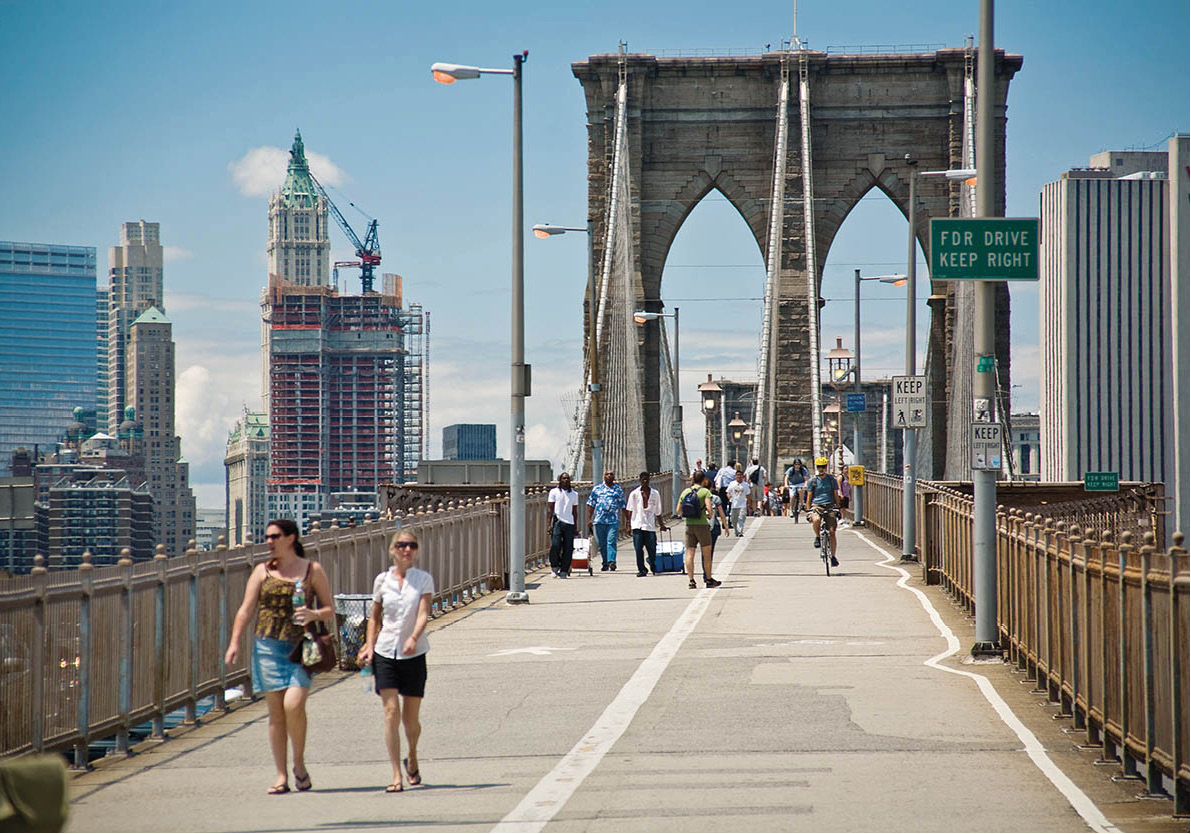
The Brooklyn Bridge and Lower Manhattan skyline
Richard Nowitz/Apa Publications
There are a few other sights of interest to visitors in Lower Manhattan. At the corner of Broadway and Fulton streets is St Paul’s Chapel and its churchyard. George Washington worshiped here after his inauguration; you can see the pew in which he sat, to your right as you enter.
A little farther up at 233 Broadway stands the Woolworth Building, which reigned as the world’s tallest building from 1913 until the Chrysler Building ushered in the skyscraper age in 1930. You can’t go upstairs, but take a look at the ornate lobby. Just up Broadway is New York City Hall, which is fairly unassuming. And if you are in the mood for a stroll, there is none more scenic or interesting than a trip by foot across the Brooklyn Bridge 7 [map], which opened in 1883. Before it was built, the only way across to Brooklyn was by ferry. The entrance to the pedestrian walkway is on the east side of City Hall Park; take a walk all the way to Brooklyn Heights.
One more detour may be in order for history buffs. At 241 Water Street is the Seaman’s Church Institute, which has a gallery and ship models. However, many are drawn to the area for what lies across the street, the Titanic Memorial Lighthouse, erected in memory of those lost on the ill-fated ocean liner.
South Street Seaport
A final area of interest in this part of Lower Manhattan is the South Street Seaport. At the foot of Fulton Street on the East River, this 11-acre (4-hectare), nine-block enclave was once in the middle of the nation’s busiest working docks. Yet its usefulness faded, and the area was turned into a pedestrian mall in the 1960s. The South Street Seaport Museum (www.southstreetseaportmuseum.org) and the area’s other attractions have now reopened following restoration from damage sustained during Hurricane Sandy in 2012.
Pier 17 8 [map] remains a popular spot for shopping and dining. The Fulton Fish Market operated in this location for almost two centuries until 2005, when it was re-located to a new indoor facility in the Bronx. The pre-dawn hours on Fulton Street no longer echo with the shouts of fish-sellers and the squawking of seagulls.
Broadway
The name Broadway is synonymous with glitz, glamour, theaters, shows, musicals and entertainment. The Great White Way, referring to the stretch between 40th and 53rd streets, takes its pseudonym from when it was first lit with electric lighting. Its heyday was in the 1920s and ’30s, when there were over 80 theaters on and around Broadway. The most famous section was 42nd Street, so famous in fact that theater owners with properties on 41st or 43rd Street, built passageways through entire blocks just to be able to boast a ‘Forty-Second Street’ address.
West MIDTOWN – TheatER District
When visitors think of New York and the Big Apple, this intersection of Broadway and Seventh Avenue is usually considered the center of it all. It is also the heart of the Broadway theater district.
Times Square and Broadway
Once a seedy, unpleasant place, Times Square 9 [map] lies at the intersection of Broadway and Seventh Avenue, at the heart of Manhattan’s theater district. This is roughly the area between 42nd and 53rd streets, between Sixth and Eighth avenues. Back in the Taxi Driver years of the 1970s, it had reached a distinct low point. For a time, the area may have been the ‘crossroads of the world,’ but perhaps only for the down and out.
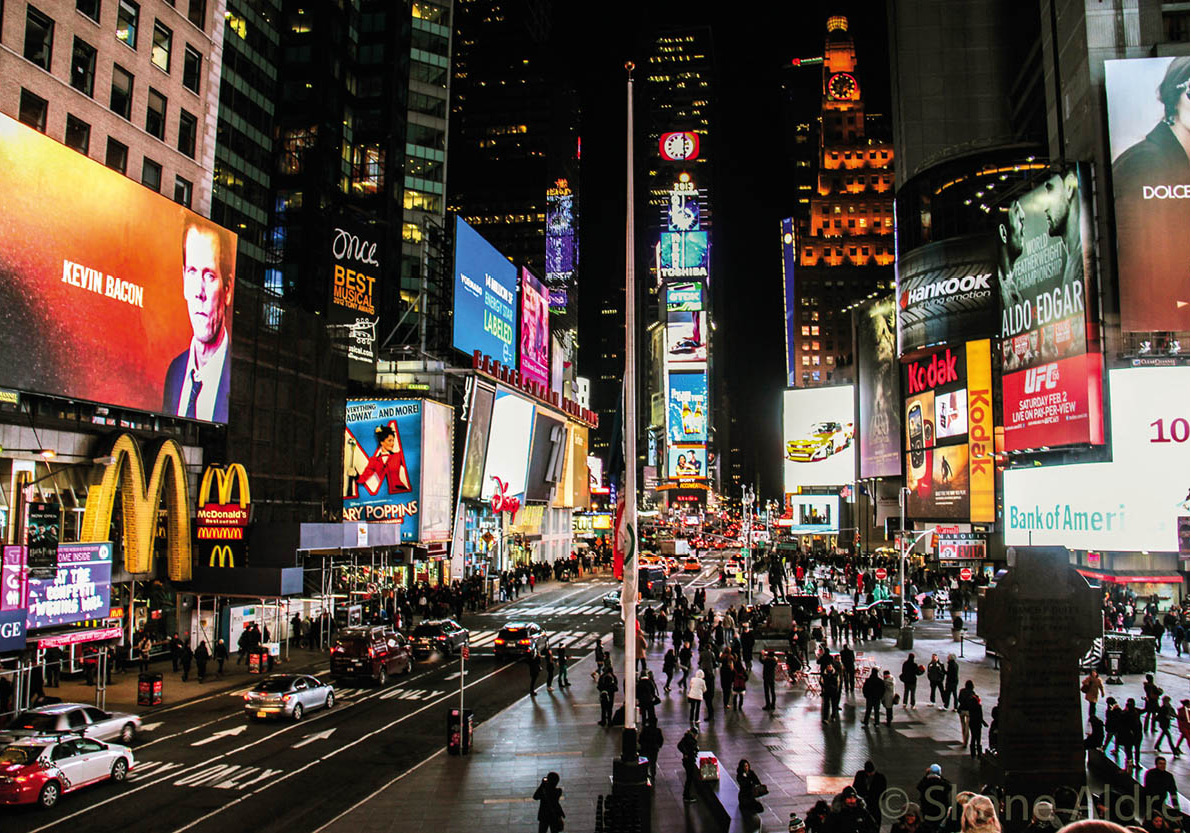
Times Square
iStockphoto
All that changed in the mid-1990s in Mayor Rudolf Giuliani’s clean-up of the area. Gone are most of the hustlers, prostitutes, pornographic theaters and bookstores; in their place are smart office buildings, hotels, stores, restaurants, and other attractions that appeal to New Yorkers and tourists alike. Even the traffic jams are gone. Broadway from 47th to 42nd streets is now entirely pedestrianized. One can debate whether this change has made the area blander, but it certainly has been revived. The ‘square’ is named for the New York Times, whose headquarters was once at 1 Times Square, where the ball still drops on New Year’s Eve. The Times has since moved premises twice, most recently to a 52-story skyscraper on 40th Street, but the square’s name will probably never change. Other features of the square include the cylindrical NASDAQ Building at 43rd and Broadway, its huge electronic display providing up-to-the-minute financial news. At the corner of 44th Street is the Viacom building, where MTV’s Times Square Studio is located. On the east side of the Square (also at 44th Street), is the corner studio for Good Morning America.
North of Times Square
Across Broadway (between Seventh Avenue and Broadway at 47th Street), you can’t miss the glowing red steps in Father Duffy Square, the northern triangle of Times Square. Enjoy a break on the steps as you watch the hustle and bustle of the Times Square. Under the steps you will find the TKTS booth, which offers discounted tickets for same-day Broadway and off-Broadway plays and musicals.
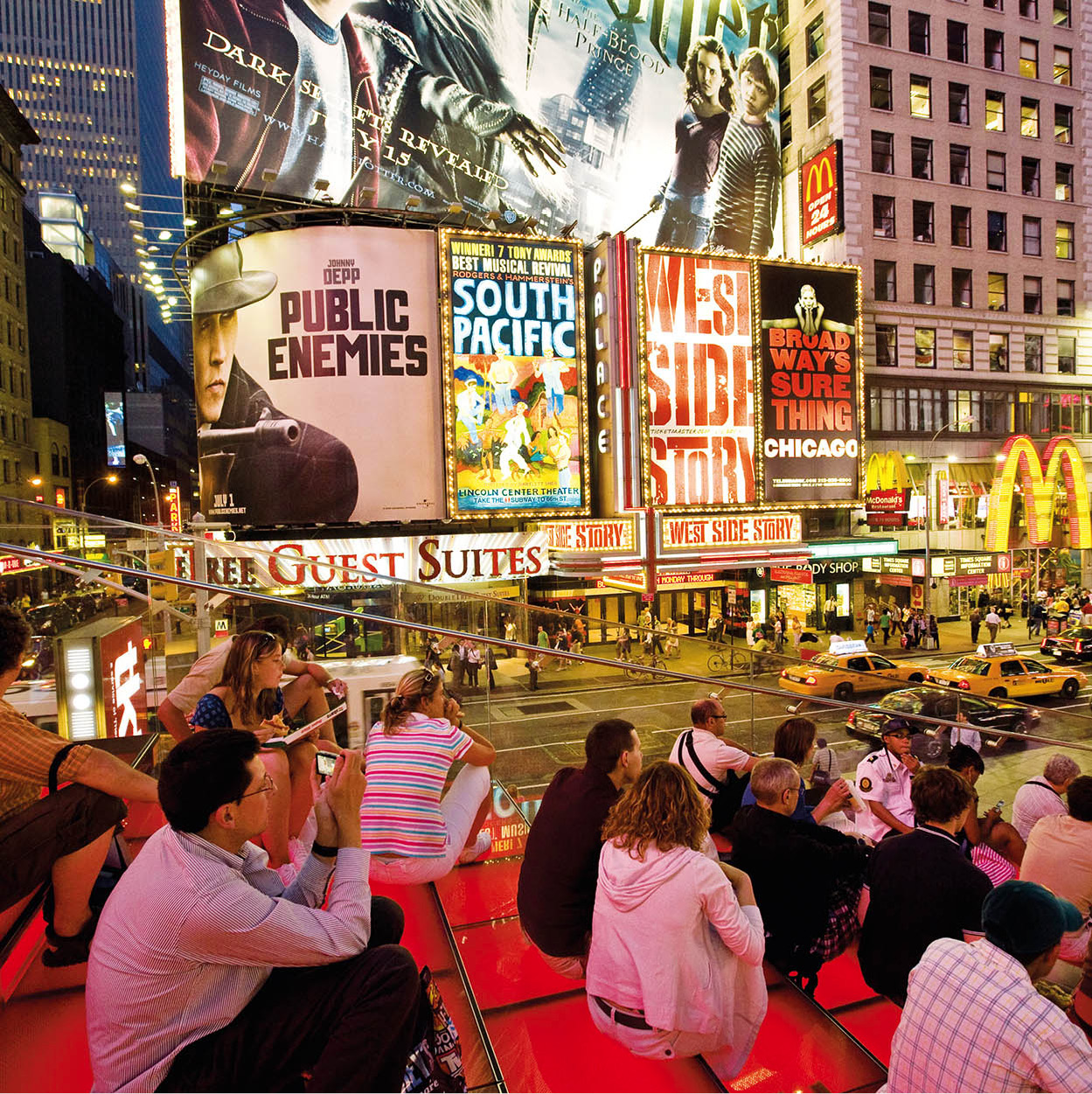
A ringside seat on the steps in Father Duffy Square
Richard Nowitz/Apa Publications
Further north at 1697 Broadway is the Ed Sullivan Theater, where The Late Show with Stephen Colbert is based. There is an official NYC Information Center for visitors at 810 Seventh Avenue (52nd and 53rd streets). At 131 W. 55th Street (between Sixth and Seventh avenues) is City Center. Once a Masonic hall, it is now a theater, dance complex and the home of Manhattan Theatre Club. Two blocks north is Carnegie Hall (154 W. 57th Street), one of New York’s most famous performing arts spaces; the main concert hall (the Isaac Stern Auditorium) is said to have the best acoustics in New York.
West 42nd Street
West of Times Square, on 42nd Street are some of the refurbished theaters and entertainment centers. On the north side of 42nd Street is the New Victory Theater, which specializes in children’s productions; beyond the Foxwoods Theatre are two movie theaters facing eachother across the street, the 13-screen E-Walk entertainment complex and the 25-screen AMC Empire. On the south side of 42nd Street is a Madame Tussaud’s Wax Museum. On the northeast corner of 42nd and Broadway is the Condé Nast Building, publisher of numerous glossy magazines.
Carnegie Hall
Financed by the iron and steel magnate Andrew Carnegie, Carnegie Hall was first opened in 1891. Fully refurbished, it is one of the great music venues of the city. If you can’t make it to a concert here, at least have a look at the excellent museum.
At Eighth Avenue, is the Port Authority of New York, the city’s main bus station. Once the scariest place in Manhattan, it is still not picturesque, but is a thriving and not unpleasant commuter hub where you can get the bus without being descended on by scores of touts and hustlers. Today the neighborhood is dominated by the New York Times Building, completed in 2007; it ties with the Chrysler Building (for more information, click here) as the fourth-tallest building in New York.
At the far western end of 42nd Street, Pier 83 is the home to the Circle Line, which offers tours around Manhattan (for more information, click here). A little further north, on Pier 86, at 46th Street and Twelfth Avenue, is the popular Intrepid Sea-Air-Space Museum ) [map] (www.intrepidmuseum.org; daily 10am–5pm, until 6pm on summer weekends; charge). The Intrepid, a decommissioned US Navy aircraft carrier, is packed with exhibits on sea exploration and warfare, space travel, and aviation. You will also find here the submarine USS Growler, a Concorde supersonic airliner, and the space shuttle Enterprise.
Central Midtown
Midtown has a wealth of cultural and shopping attractions, from art (MoMA), to literature (New York Public Library) and the department stores of Fifth Avenue.
Diamond District
West 47th is New York’s Diamond District, an area dominated by mostly Orthodox Jewish diamond dealers; unbelievably, the majority of the diamonds that pass through New York find their way to this unassuming street. While this may be a good place to shop for diamonds, it is questionable as to whether or not you’ll find any real bargains at the jewelry or ‘discount’ electronics stores.
Bryant Park
East of Times Square on 42nd Street, between Sixth and Fifth avenues, are the green and leafy expanses of Bryant Park, another great New York restoration project of the early 1990s. The present French-style layout of the park dates from the Great Depression, but by the 1980s it had become a no-man’s land of drug dealers night and day. Now it is one of midtown’s most pleasant oases, where office workers gather in the summer months for lunch or just to relax. Next to the park is the New York Public Library ! [map], a grand Beaux-Arts-style building that dates to 1911; two handsome, famous and much-photographed stone lions, Patience and Fortitude, flag its Fifth Avenue entrance. One of the largest research libraries in the world, the structure houses several million books, almost as many manuscripts, and several vast reading rooms. The main reading room has been modernized, but nevertheless retains its original grandeur. Changing exhibitions are regularly mounted in the library’s exhibition halls.
Just north of Bryant Park at 1133 Sixth Avenue at 43rd Street, the International Center of Photography (www.icp.org; Tue–Sun Fri until 8pm; charge) houses a collection of over 100,000 images covering the entire history of photography, in the heart of midtown.

New York Public Library
Britta Jaschinski/Apa Publications
Rockefeller Center
The centerpiece of central Manhattan, covering 22 acres (9 hectares) between Fifth and Sixth avenues, from 47th to 51st streets, is Rockefeller Center @ [map]. The buildings in this complex are linked by underground walkways and concourses, which are themselves filled with shops, a post office, and restaurants. Columbia University purchased the site in 1811 when it was still farmland. In 1928, John D. Rockefeller, a founder of the Standard Oil Company, asked the university for a lease on the site to raise a commercial complex. Built mostly between 1931 and 1940, Rockefeller Center attracts thousands of office-workers, visitors, and shoppers daily.
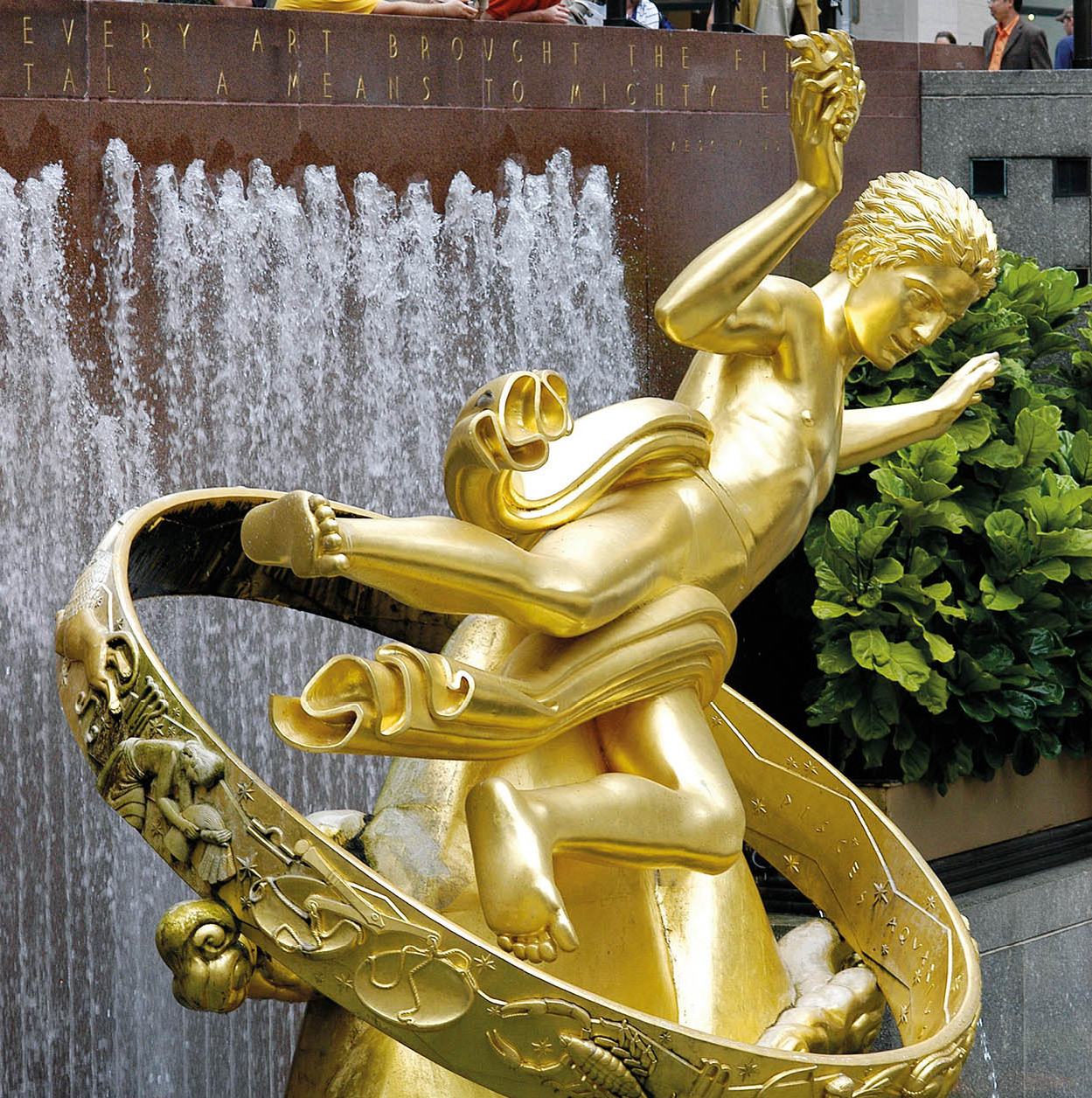
Statue of Prometheus
Britta Jaschinski/Apa Publications
From Fifth Avenue you enter via the Channel Gardens, a sloping walkway divided by fountains and flowerbeds between the British and French buildings, which end at the sunken plaza and its famous ice rink and gilded statue of Prometheus. This is also where the giant Christmas tree is placed (right behind Prometheus). If you have time, wander around and admire some of the Art Deco details.
Nowadays, the GE Building (30 Rockefeller Plaza, the largest building in the complex) is better known as the headquarters for the NBC television network and the Today Show; the glassed-in studio is across the street from the building’s southeast corner, at 49th Street.
The GE Building’s observation deck is called Top of the Rock (entrance on W. 50th Street; www.topoftherocknyc.com; daily 8am–midnight; charge), and offers visitors an unparalleled and unobstructed 360-degree view of the city from the 70th floor. The elevator to the top features a transparent ceiling so that visitors can view their rapid ascent all the way up the elevator chute. A light show and projected images add to the fun of the ride.
Also at this corner is the NBC Experience, a combination attraction and merchandise store festooned with the logos of the network and some of its television shows. You can also purchase tickets here for the extremely popular NBC Studio Tour (www.nbcstudiotour.com; daily 8.30am–5.30pm, Mon–Thur tours every 30 mins, Fri–Sun tours every 15 mins).
Radio City Music Hall (corner of Sixth Avenue and 50th Street) is one of the largest theaters in the world, with a seating capacity of around 6,000. This restored Art Deco masterpiece is a popular location for seasonal theme shows, including the dazzling Christmas Spectacular; it’s also the home of the ever-popular Rockettes. Tours can be arranged by tel: (212) 247-4777, or at www.radiocity.com.
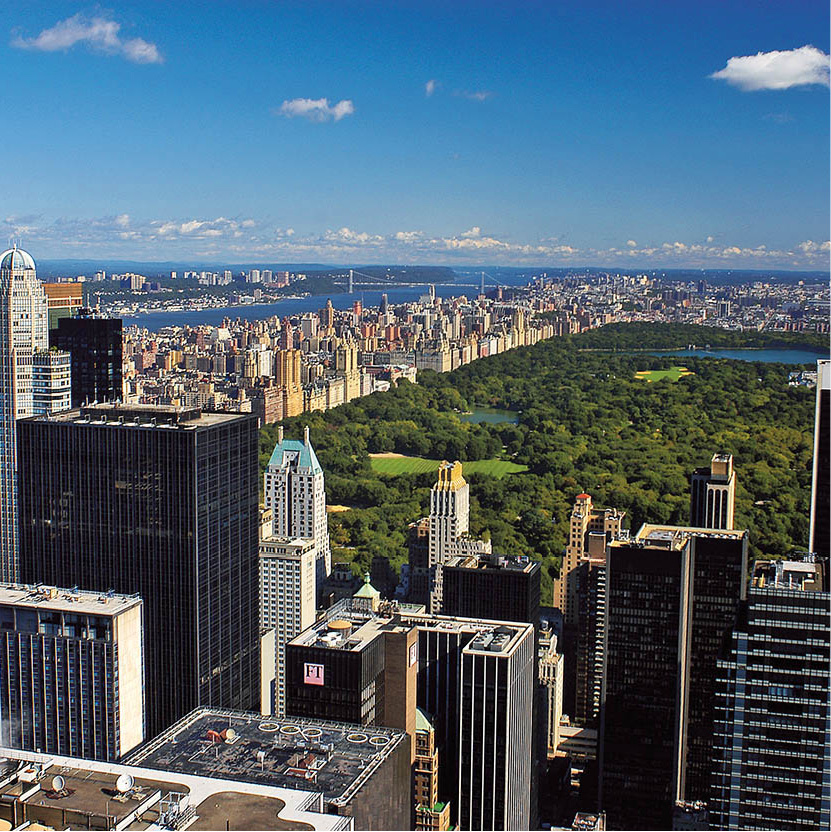
The view from Top of the Rock
Abe Nowitz/Apa Publications
Fifth Avenue
At the turn of the 20th century, Fifth Avenue was the location of some of the largest and most opulent mansions in New York. After World War I, a number of fashionable and expensive stores opened for business here. You’ll still find Saks Fifth Avenue (50th Street), Henri Bendel (55th and 56th streets), Tiffany’s (57th Street), and Bergdorf Goodman (58th Street), though most of the trendiest designers now have their boutiques on Madison Avenue. The gaudiest addition to Fifth Avenue has without a doubt been Donald Trump’s Trump Tower (56th and 57th streets), where a ‘wall’ of water slides down rose marble set between gleaming brass escalator rails.
St Patrick’s Cathedral £ [map], on Fifth Avenue (50th and 51st), was the tallest building in the vicinity when it was built between 1858 and 1879. Today, it appears somewhat dwarfed by the skyscrapers of Rockefeller Center and the apartment building next door, though the juxtaposition of its soft gray granite and the surrounding glass creates a stunning image. Seat of the Archdiocese of New York City, the church is the focal point of the Irish parade on St Patrick’s Day.

St Patrick’s Cathedral
Britta Jaschinski/Apa Publications
At the corner of Fifth Avenue and 59th Street, busy Grand Army Plaza marks the division between Fifth Avenue’s shopping area and the residential section, which is lined with exclusive apartment buildings and a few remaining mansions. This is the place to hire a horse-drawn carriage for a ride round Central Park (for more information, click here). It is also the site of two of New York’s most famous hotels, the Plaza and the Pierre (at East 61st Street).
Across from the plaza is the General Motors Building. A distinctive 32ft (10m) glass cube in front of it marks the entrance to the subterranean Apple Store (767 Fifth Avenue), where you can browse among the latest cutting-edge iPads, iPhones, and other Apple products 365 days a year, 24 hours a day.
Museum of Modern Art
One of midtown’s most important cultural centers is the Museum of Modern Art $ [map], or MoMA (www.moma.org; daily 10.30am–5.30pm, Fri until 8pm; charge), located on 53rd Street between Fifth and Sixth avenues. From 2002–2004, a complete redesign by architect Yoshio Taniguchi doubled the museum’s exhibition space. The museum has also purchased the building next door – the former home of the American Folk Art Museum – and is planning further expansions.
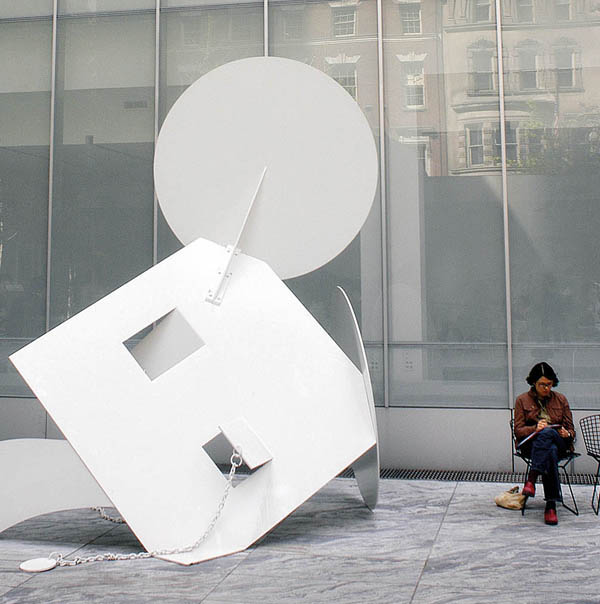
MoMA’s sculpture gardens
Britta Jaschinski/Apa Publications
Devoted to works of art created after 1880, roughly from the Impressionists on, the collection includes such masterpieces as Dalí’s The Persistence of Memory, Van Gogh’s The Starry Night, Rousseau’s Sleeping Gypsy, Wyeth’s Christina’s World and Warhol’s Gold Marilyn Monroe. The collection also includes a number of Monet’s Water Lilies, as well as important works by Picasso, Jackson Pollock, Mark Rothko and Chuck Close.
Modern sculpture is not ignored, and there are examples of everything from Marcel Duchamp’s bicycle wheel to huge installations by contemporary artists. The modern sculpture garden remains a distinctive element of MoMA.
The flagship MoMA design store, a great place to buy artistically designed household wares, is located within the museum; a second store is across the street at 44 West 53rd Street. There is a third in SoHo (81 Spring Street).
East Midtown
In this area you will spend much of your time looking up at major architectural landmarks, including the ceiling of Grand Central and the Chrysler Building.
Madison and Park Avenues
The streets east of Fifth Avenue have several places of interest to visitors. The Sony Wonder Technology Lab in the Sony Building at Madison Avenue and 56th is aimed at the younger set; parents can shop at Sony Style downstairs. The 57-story tower of the New York Palace Hotel (East 50th and 51st) incorporates the historic Villard Houses, which date to 1882. Take a walk through the grand lobby if you are in the area.
A Park Avenue landmark is the Waldorf-Astoria Hotel, which takes up the entire block between Park and Lexington from 49th to 50th. It has been host to world leaders since 1931. Nearby, the bronze-and-glass Seagram Building, on Park Avenue between 52nd and 53rd, is the only New York building designed by Mies van der Rohe; it’s also the home of the famous Four Seasons restaurant (52nd Street). Across the street, at 390 Park Avenue, is the 24-story Lever House. Built in 1952 it was one of the first glass-walled office buildings in the States.

Grand Central Terminal
Britta Jaschinski/Apa Publications
Grand Central and the Chrysler Building
After a complete restoration and renovation project in the late 1990s, Grand Central Terminal % [map] (at 42nd between Park and Lexington) has been returned to its former splendor. Completed in 1913, the building is a Beaux-Arts masterpiece. Inside, more than 40 platforms split between two levels serve dozens of rail lines. The central concourse is vast but also light, airy, and harmonious under a blue-green, star-sprinkled ceiling 12 stories tall. It is invaded every afternoon from 4–6pm by hundreds of thousands of suburban commuters catching their trains home to points north of Manhattan. If you enter from the Vanderbilt Avenue side, look across the lobby to see the grand staircase. Inside the station are restaurants, shops, and, on the lower level, the famous Oyster Bar & Restaurant, a favorite for power-lunchers. Free tours are offered daily at 12.30pm by the Municipal Arts Society (meet at the information booth on the Grand Concourse; tel: 212-935 3960), and on Fridays by the Grand Central Partnership (meet at 12.30pm in the sculpture court at 120 Park Avenue, located at the southwest corner of East 42nd Street and Park Avenue directly across from Grand Central Terminal; tel: 212-883 2420).
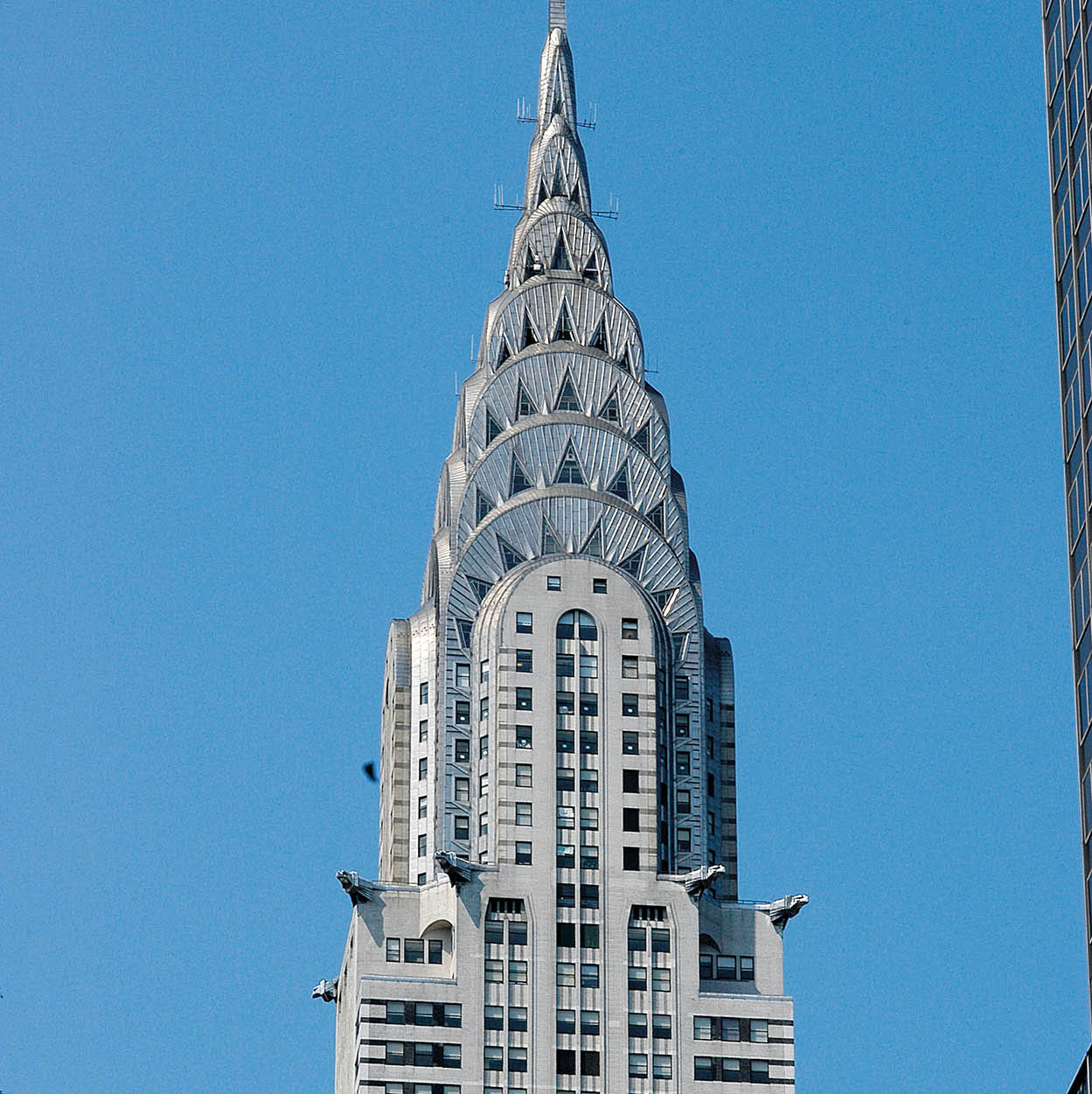
Chrysler Building
Britta Jaschinski/Apa Publications
Across Lexington Avenue on 42nd Street stands the most beautiful skyscraper of all, the Chrysler Building ^ [map], a silvery Art-Deco needle completed in 1930. For a few months it was the tallest structure in the world, but it was rapidly surpassed by the Empire State Building (for more information, click here). The stylized eagle heads on the upper corners were modeled on the Chrysler automobile’s 1929 radiator cap.
At the corner of Second Avenue, even more fine Art-Deco architecture distinguishes the former Daily News Building; the lobby, with its huge revolving globe, is well worth a look. The paper moved to a new location west of Penn Station in the mid-1990s. Also well worth a look is the Ford Foundation headquarters (320 East 43rd Street); offices open onto a spacious interior court with trees – New York’s first office-building atrium. It’s another of the city’s fine public spaces.

The UN Building
Britta Jaschinski/Apa Publications
United Nations
The eastern end of 42nd Street used to be a warren of tenements and slaughterhouses, but thanks to John D. Rockefeller, Jr., it is now the home of the United Nations & [map]. A team of architects, including Wallace K. Harrison, Le Corbusier, and Oscar Niemeyer, designed the buildings. They were completed in the early 1950s. The Secretariat is housed in the glass-and-marble structure, while the General Assembly meets in the lower building with the slightly concave roof. The flags of the member nations flutter from the flagpoles along First Avenue.
When the General Assembly is not in session, visitors from around the world take daily multilingual tours of the General Assembly Hall and Council Chambers, the sculptures in the grounds overlooking the East River and Queens, and informative documentary exhibits. A highlight is the meditation room adorned with stained-glass windows by Chagall.
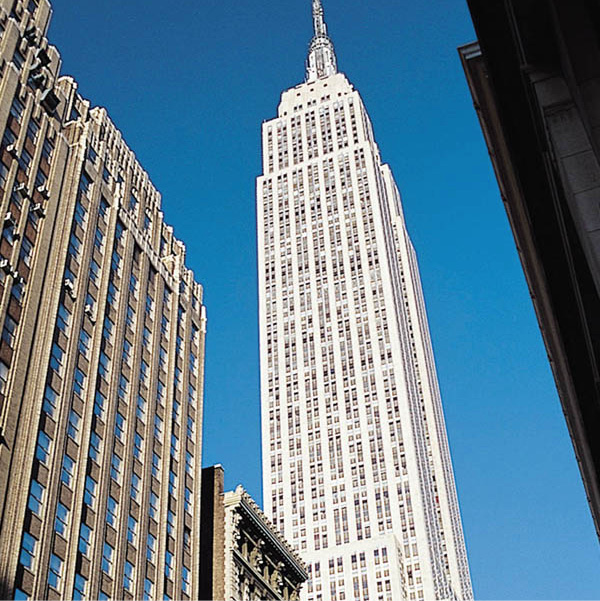
The Empire State Building
Anna Mockford & Nick Bonetti/Apa Publications
South Midtown
The Empire State Building * [map] (www.esbnyc.com; corner of Fifth Avenue and 34th Street; daily 8am–2am; charge) no longer holds the title of tallest building in the world. Yet, it is otherwise everything a skyscraper should be: 102 stories; 60,000 tons of steel; 3,500 miles (5,632km) of telephone wires and cables; 60 miles (97km) of pipes; a total volume of 1.25 million cubic yards (1 million cubic meters); 1,860 steps, and of course, its towering height – 1,453ft (443m), including the lightning rod (overall, half as tall again as the Eiffel Tower). Opened in 1931 in the depths of the Great Depression, the building took just two years to complete. The 86th-floor Observation Deck provides stunning views of New York. On the outside terrace you can see much of Manhattan, including Central Park, and on a clear day you can see ships 40 miles (64km) away. You can also visit the 102nd floor observatory (additional charge), from which King Kong swatted wasp-like attacking airplanes.
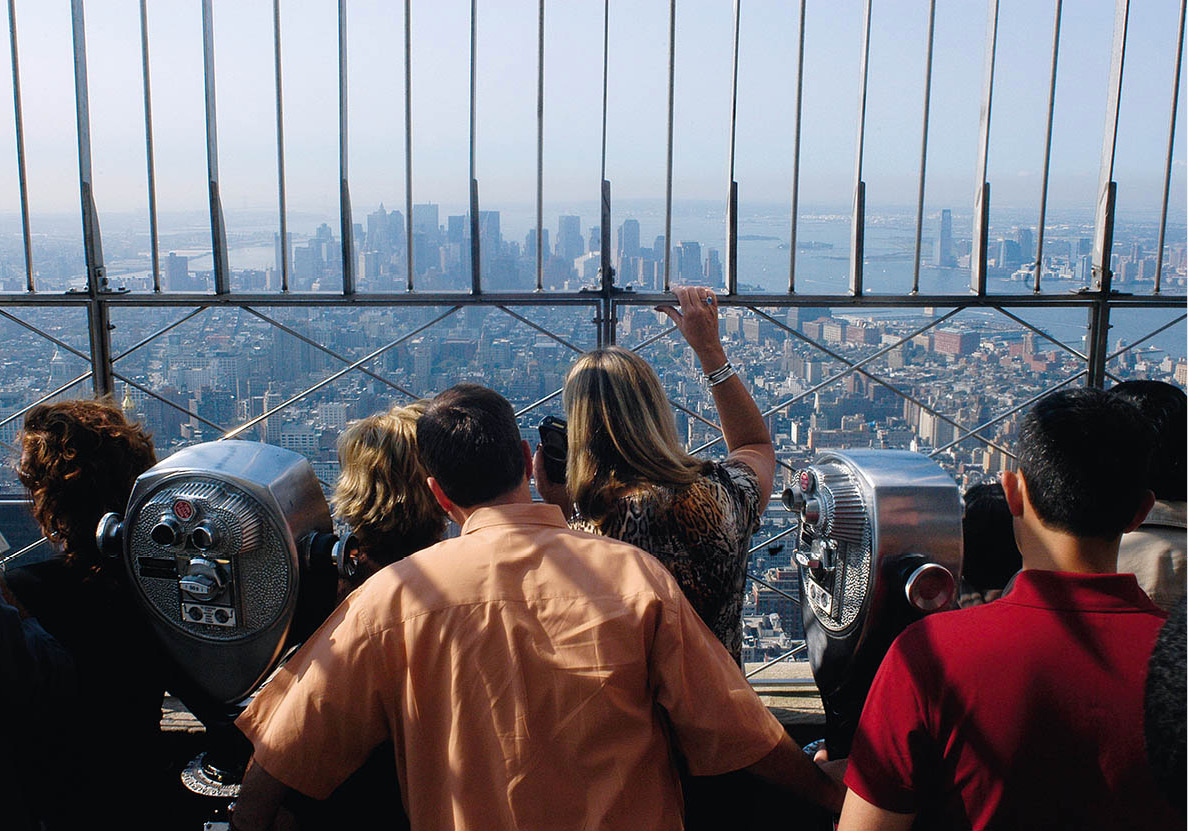
Taking in the view from the Empire State’s observation deck
Britta Jaschinski/Apa Publications
Back on earth, you can walk west along 34th Street to visit Macy’s (Sixth and Seventh avenues), New York’s most famous and largest department store. Nearby, at Seventh Avenue and 33rd Street, is Madison Square Garden, renowned for boxing matches and rock concerts. In addition to being home to the New York Knicks (basketball) and the Rangers (ice hockey), it is also used as a conference center. The Garden seats 20,000 people and its adjacent theater can take an additional 5,000. Under Madison Square Garden is Pennsylvania Station (usually referred to as Penn Station), the railway terminal for New Jersey and Long Island commuters and the Manhattan stop for Amtrak. Across Eighth Avenue is the General Post Office, which was a twin to the old Penn Station, torn down in the late 1960s to make room for Madison Square Garden. Moynihan Station, an expansion of Penn Station under Eighth Avenue, is scheduled for the future, along with a new rail tunnel below the Hudson River.
If you are in town for a trade show, chances are that you will head for the Jacob K. Javits Convention Center, the city’s largest exhibition center, a striking building on Eleventh Avenue between 34th and 37th streets. Designed by I. M. Pei, the center was named for New York state’s long-time Republican senator.
To the east of the Empire State Building, at 36th and Madison in Murray Hill, is another prominent landmark: the Morgan Library. The personal collection of J. Pierpont Morgan includes rare books and manuscripts, three Gutenberg Bibles and Florentine sculpture and art. Often overlooked by tourists, it is a quiet place, which is one of its pleasures.
CityPass
One way to see several of Manhattan’s top attractions and to save some money at the same time is to buy a CityPass. The pass gives you admission to six leading attractions for only $106, considerably less than the total for individual full admission prices. Attractions include the Empire State Building Observation Deck, the Museum of Modern Art, the Metropolitan Museum of Art, the American Museum of Natural History, the Guggenheim Museum or Top of the Rock, and Circle Line Sightseeing Cruises or Statue of Liberty and Ellis Island. The pass can be used for nine consecutive days and should enable you to avoid most ticket lines. Buy it online at www.citypass.com, or at any of the participating attractions.
Upper East Side – The Museum Mile
Home to many famous museums, the Upper East Side starts at 59th Street, at the corner of Central Park. Beyond the east 60s, much of this area is residential, and includes some of Manhattan’s most expensive real estate.
Most of the Upper East Side’s museums are located along the ‘Museum Mile’ from 82nd to 110th streets. But there are a few exceptions. One is the Mount Vernon Hotel Museum and Garden, at 421 East 61st Street (www.mvhm.org; First and York avenues; Tue–Sun 11am–4pm; charge). This Federal-style house, which dates from 1799, is an interesting period piece for those with time and interest, featuring 19th-century furnishings and decorative arts.
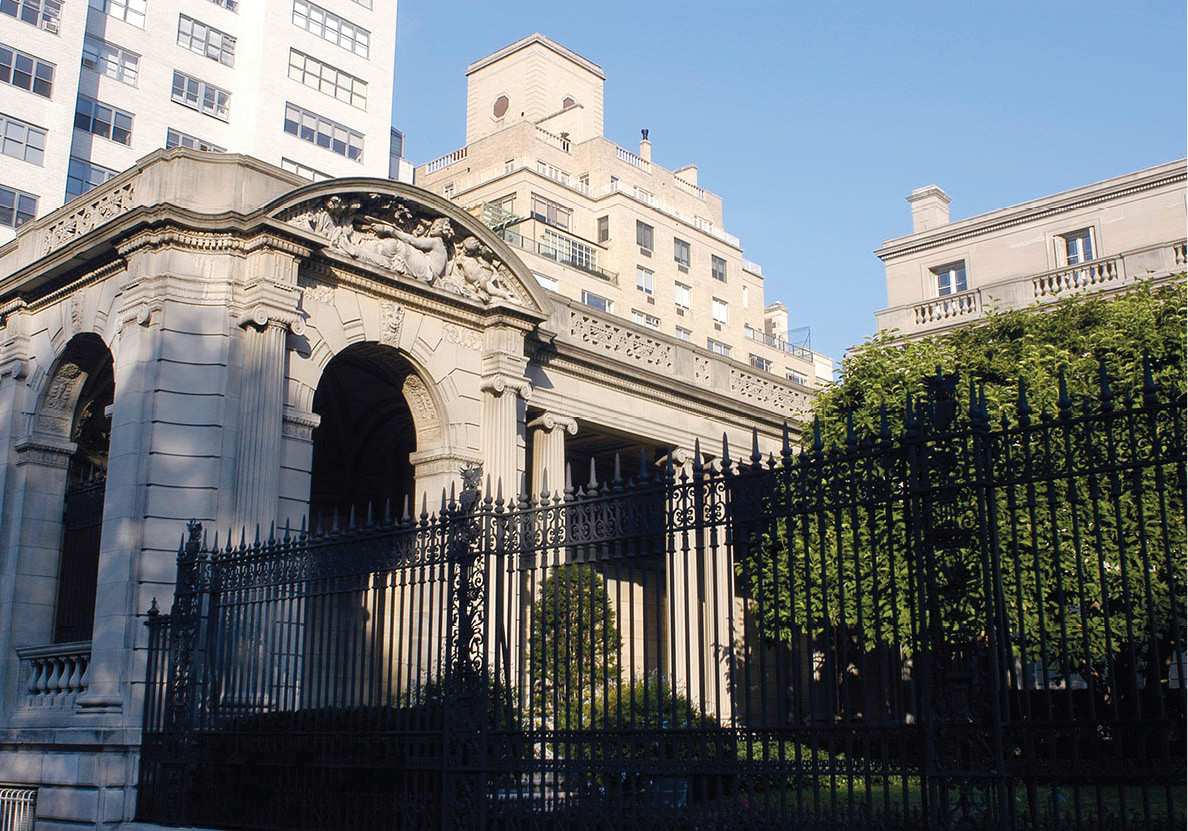
The Frick mansion
Britta Jaschinski/Apa Publications
Frick Collection
A few other major museums are just off the Museum Mile proper. The Frick Collection ( [map] at 70th Street and Fifth Avenue (www.frick.org; Tue–Sat 10am–6pm, Sun 11am–5pm; charge) is situated in the former mansion of coal and steel baron Henry Clay Frick, who put together one of the finest private collections of art in the US (mostly European paintings and sculpture). Upon the death of Frick’s widow in 1931, their home, which was designed by Thomas Hastings, and the art therein, were donated to the city of New York as a museum; it opened in 1935 after a reconstruction designed by John Russell Pope. Visitors have the pleasure of seeing not only beautiful works of art but also the mansion and its gardens, much as they were when the Fricks lived there; it is a rare and wonderful experience. In addition to three Vermeers (including Mistress and Maid), the museum holds fine works by Hans Holbein (Sir Thomas More and Thomas Cromwell), El Greco (St. Jerome), Bellini (St. Francis in Ecstasy), Boucher, Titian, Goya, Whistler, Rembrandt, and Velázquez; exquisite European furniture; and one of the largest collections of small bronze sculptures in the world.
Asia Society
The attractive redgranite building on the northeast corner of Park Avenue and 70th Street is the headquarters of the Asia Society (www.asiasociety.org; Tues–Sun 11am–6pm, Fri until 9pm (except Jul–mid-Sept); charge). The society mounts regular, imaginative exhibitions of ancient and modern Asian and Pacific art, assembled from private collections, as well as from its own permanent collection.
Metropolitan Museum of Art
Museum Mile begins at the Metropolitan Museum of Art , [map], located at 82nd Street and Fifth Avenue (www.metmuseum.org; Sun–Thur, Sun 10am–5.30pm, Fri–Sat 10am–9pm; charge). Monumentally huge, the ‘Met,’ as it is affectionately known, is a repository for all things cultural, from Egyptian mummies to Roman bronzes, Chinese pottery and wonderful Impressionist paintings. Founded in 1870, the institution owns over 2 million items, though only around a quarter of the total collection is on display at any one time in its nearly 250 rooms. The Art of the Arab Lands galleries are worth a closer look, especially the textiles and the stunning 16th-century decorative ceiling of interlocking stars and polygons. More than 5,300 works of classical art are on show in the refurbished Greek and Roman galleries. Children love the Egyptian treasures (the best such collection in the US), especially the Temple of Dendur, which sits in its own room.
Don’t miss the American Wing, particularly the Garden Court, where stained-glass windows, fountains, sculptures, plants and benches create a tranquil environment. On all sides are period rooms and other galleries that show off the Met’s fine holdings in American art. Among the famous paintings are Emanuel Leutze’s Washington Crossing the Delaware, Albert Bierstadt’s The Rocky Mountains, as well as notable works by Winslow Homer.

The Whitney Museum has now moved from the Upper East Side
Britta Jaschinski/Apa Publications
European paintings, sculpture, and decorative arts before 1800 include Botticelli’s Last Communion of St. Jerome, Giovanni di Paolo’s Adoration of the Magi, Rembrandt’s Self-Portrait, 1660, and works by Bellini, Ingres, El Greco, Holbein, Goya, and virtually any other famous painter you can name. Similarly stellar is the collection of 19th-century European paintings and sculptures, including works by such luminaries as Van Gogh, Monet, Renoir, and Degas. The Robert Lehman Collection, at the west end of the main floor, comprises fine Old Masters and Italian Renaissance paintings, including several period rooms recreated from Lehman’s home. The Michael C. Rockefeller Wing houses a good collection of primitive art.
The Lila Acheson Wallace Wing, devoted to modern art, remains one of the most popular sections of the Met. It features paintings, sculptures, and decorative arts from Europe and America, including Picasso’s Gertrude Stein and works by major modern artists including Jackson Pollock, Willem de Kooning, Edward Hopper, Georgia O’Keefe, Diego Rivera, Frank Stella, and Chuck Close.Modern sculpture is often on view in the roof garden overlooking Central Park, where there is a café in the summer. On top of all this, the Met has one of the best art bookstores in the US.
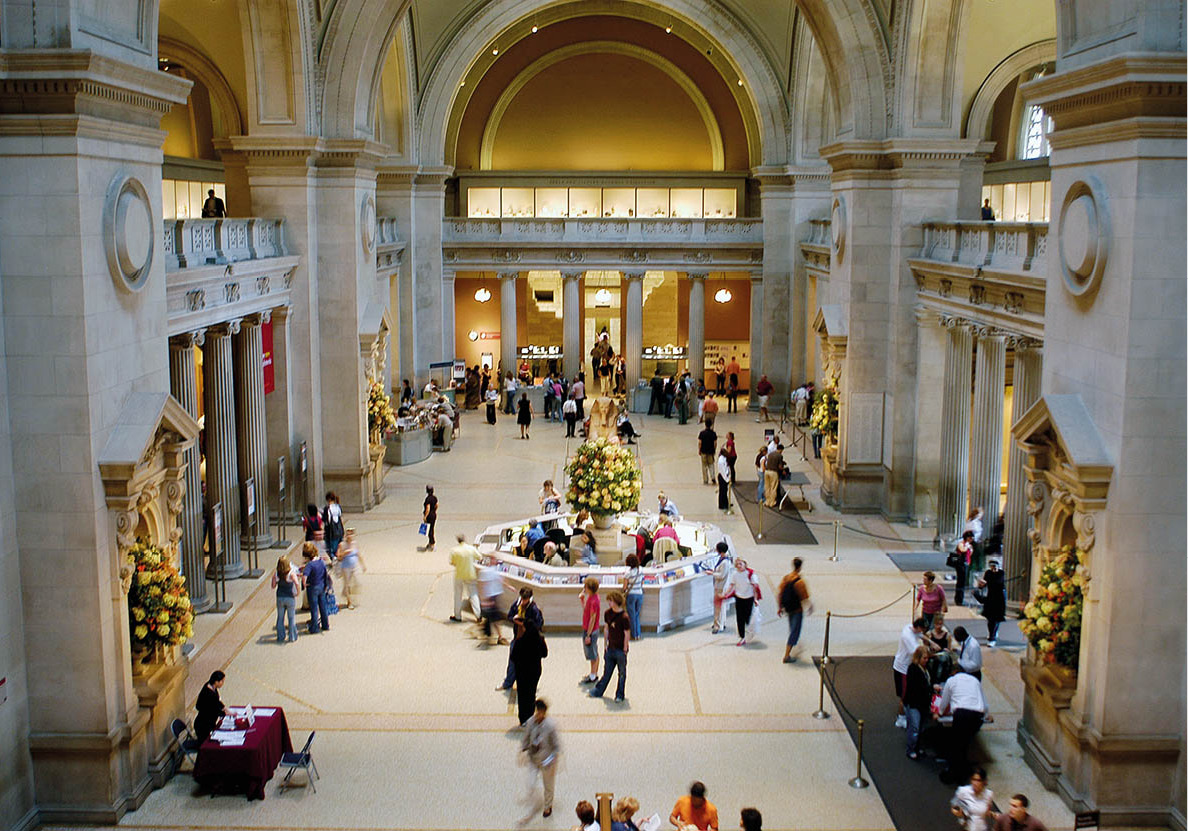
The Metropolitan Museum of Art
Britta Jaschinski/Apa Publications
Neue Galerie
Four blocks north of the Met (1048 Fifth Avenue at 86th Street) is the Neue Galerie (www.neuegalerie.com; Thur–Mon 11am–6pm; charge), a small but unique museum that specializes in early 20th-century German and Austrian art and design, featuring works by Gustav Klimt and various Bauhaus exponents. It is housed in an elegant mansion built in 1914 for the industrialist William Starr Miller by Carrère and Hastings, architects of the New York Public Library; the building was once occupied by society doyenne, Mrs Cornelius Vanderbilt III. The Café Sabarsky inside (for more information, click here) is a recommended stop too.

The Guggenheim
Abe Nowitz/Apa Publications
Guggenheim Museum
At 89th Street is the Solomon R. Guggenheim Museum ⁄ [map] (www.guggenheim.org; Sat–Wed 10am–5.45pm, Fri 10am–7.45pm; charge). The building, which was designed by Frank Lloyd Wright and opened in 1959, is now a New York landmark. The concrete exterior was comprehensively restored for the museum’s 50th anniversary in 2009. The museum’s most famous feature is perhaps not its paintings but the continuous spiral ramp that connects the building’s six storeys.
The permanent collection, built on Guggenheim’s original private collection of contemporary paintings, includes works by such artists as Brancusi, Klee, Chagall, Picasso, Miró, Calder, and Kandinsky. The Justin K. Thannhauser collection, in the annex, contains paintings by Renoir, Monet, Cézanne, Van Gogh, Gauguin, and Degas. The museum’s collection is actually now spread somewhat thinly among its various branches in such disparate places as Bilbao, Las Vegas, Venice, and Berlin.
Special exhibitions
Visitors should look out for special exhibitions at the Met; no additional ticket or admission fee is required to see them.
Just across 89th Street is the National Academy Museum (www.nationalacademy.org; Wed–Sun 11am–6pm; charge), whose collection focuses on American art of the 19th and early 20th centuries.
Other museums
Nearby, at 91st Street, is the Cooper-Hewitt Smithsonian Design Museum (www.cooperhewitt.org; Mon–Fri 10am–5pm, Sat 10am–6pm, Sun noon–6pm). A branch of the Smithsonian Institution, the Cooper-Hewitt is more of a research institution than a museum, with vast holdings of furniture, wall-coverings, textiles, prints, drawings, and miscellaneous objects.
At 92nd Street, the Jewish Museum (www.jewishmuseum.org; Fri–Tue 11am– 5.45pm, Thur until 8pm, closed Fri from Dec–Feb, and Jewish holidays; charge, free Sat), housed in a gothic mansion, is an important cultural and historical museum. It holds an extensive collection of Judaica and exhibits the work of Jewish artists.
The Museum of the City of New York (www.mcny.org; daily 10am–6pm; charge) is located at 103rd Street. This treasury of materials documenting New York City’s history also includes a superb toy collection. The last institution on Museum Mile is El Museo del Barrio (www.elmuseo.org; Wed–Sun 11am–6pm; charge), at 104th Street. Americans of Hispanic origin live in many parts of the city’s boroughs, but El Barrio – the Quarter – in East (or Spanish) Harlem was the first predominantly Puerto Rican district. The museum is devoted to Latin American culture and art.
The long-gestating Museum for African Art (www.africanart.org) at 110th Street will extend the Museum Mile to the northeastern tip of Central Park. Check their website for opening details.
Central Park
The heart (some say the lungs) of Manhattan is Central Park, located between 59th and 110th streets and Fifth and Eighth avenues. This vast green space is half a mile wide and 2.5 miles long (0.8km x 4km) and is one of the main places where New Yorkers go to play. On summer weekends, residents (and visitors) come by the thousands to play ball, skate, stroll, picnic, or listen to music. But the park is busy all week long and all year long. The park’s designers were Frederick Law Olmsted and Calvert Vaux, and the project, which began in 1858, took almost 20 years to complete. Creating a usable public space from a huge, sparse, and rocky landscape was a remarkable achievement for the time and revolutionized landscape architecture. Amazingly, almost everything you see in the park today, from the Great Lawn to the lakes, to the meadows and forest in the northern end, was constructed. The park is now partially supported, administered, and overseen by the Central Park Conservancy (www.centralparknyc.org).
There is always something going on in the park, from a concert to a rally to a bicycle race. To learn more about the park you can take a walking tour. The Central Park Conservancy sponsors free guided tours year-round, rain or shine, and downloadable audio tours (see the schedule and find downloads at www.centralparknyc.org). The more active will be interested in ball fields, tennis courts, and other sporting opportunities. Since most of the park’s roads are closed on weekends, strolling, biking, and skating are popular.
Park highlights
Highlights in the southern end of the park include Wollman Rink (mid-Park at 63rd Street), which is used for ice-skating in the winter. A children’s amusement park takes over during the summer months. There’s another skating rink in the northern end of the park, Lasker Rink (between W. 106th and 108th streets), which is transformed into a very popular swimming pool in the summer.
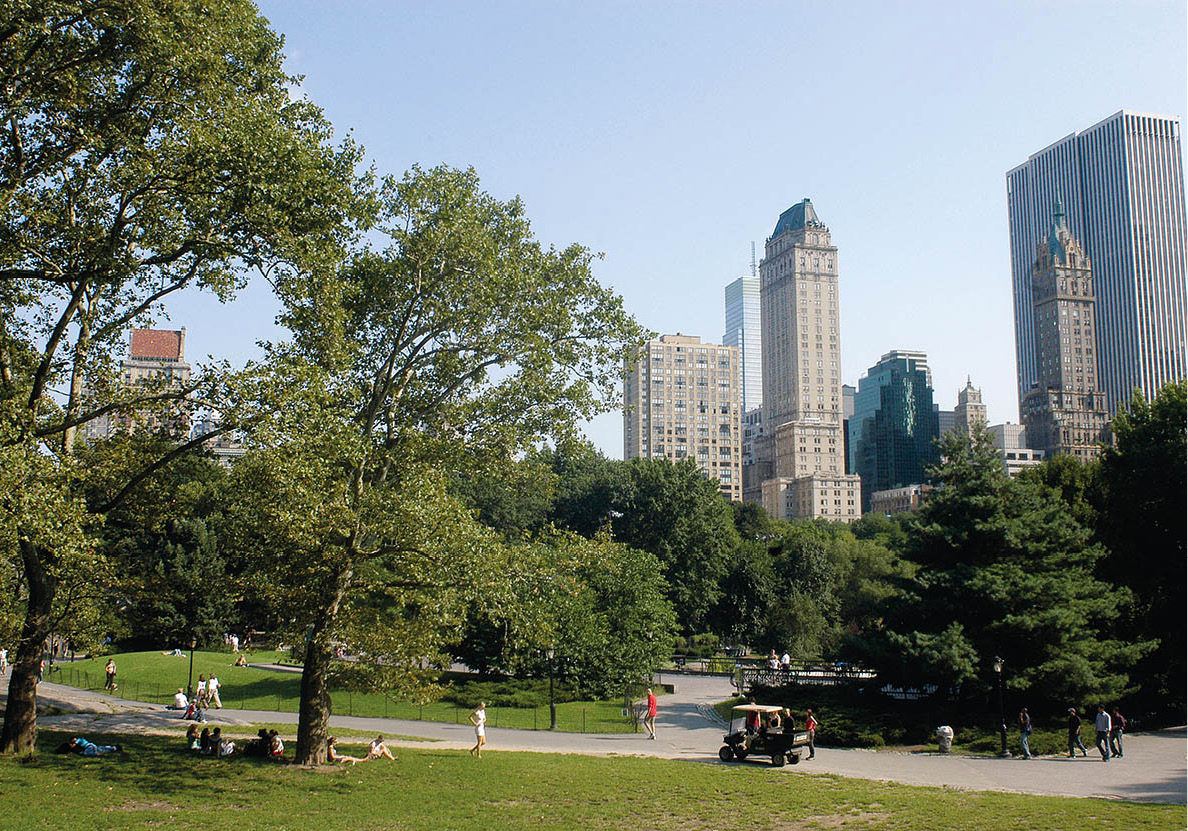
Relaxing in Central Park, the lungs of Manhattan
Britta Jaschinski/Apa Publications
Closer to Fifth Avenue is the Central Park Zoo ¤ [map], including the Tisch Children’s Zoo (www.centralparkzoo.com; Apr–Oct Mon–Fri 10am–5pm, Sat–Sun 10am–5.30pm, Nov–Mar daily 10am–4.30pm; charge). Inbetween is the Delacorte Musical Clock, which chimes the hours with musical animals. The highlights of the zoo include the sea-lion pool and polar bear house. Kids will love the petting zoo and the ‘Enchanted Forest.’ The admission charge for Central Park Zoo includes entrance to the children’s zoo, and both are open daily.
Another favorite in the southeast corner of the park is the historic Carousel, located mid-Park at 64th Street. It dates from 1908 and used to stand in a Coney Island amusement park. You can still ride it, weather permitting (Apr–Oct daily 10am–6pm, Nov–Mar; call for hours 212-439-6900 x12).
On the park’s west side, near 66th Street, is Tavern on the Green. The gardens and building are dazzling and house an information center and as of 2013, a new restaurant serving local and artisanal food. Nearby is the Sheep Meadow, a popular spot for playing Frisbee and for sunbathing in summer; it is also a great place for a picnic. The sheep that used to graze here were originally housed in the Tavern on the Green building.
Right in the middle of the park, beginning at 66th Street, is the Literary Walk, lined with statues of writers you will, for the most part, recognize. The path leads up to the Mall, where there is a band shell, and ends at the Bethesda Terrace and Fountain, one of the park’s best-known spots. On the lake is the Loeb Boathouse, where there is a café in addition to a good, though fairly expensive, restaurant. You can rent a boat or a bike near here in the summer.
The Dairy
You might want to drop in at the Dairy (mid-Park at 65th Street; daily 10am–5pm), the Central Park visitors’ center. The attractive Victorian Gothic structure was actually built as a dairy in 1870 in order to provide fresh milk to families. Today it displays a permanent exhibit on the park’s history and design and provides visitors with brochures and information.
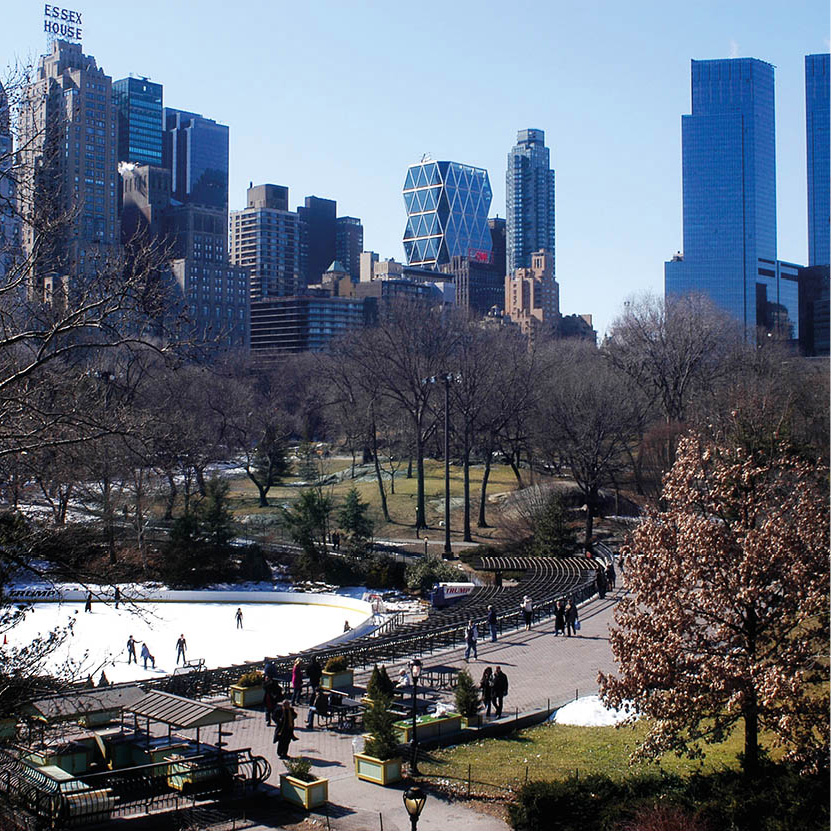
Central Park’s ice rink
Britta Jaschinski/Apa Publications
To the east is the Conservatory Water, a pond where hobbyists sail model boats. At its northern end (at 74th Street) sits Central Park’s most beloved sculpture, a bronze grouping of characters from Lewis Carroll’s Alice’s Adventures in Wonderland.
To the west is Strawberry Fields, a poigant memorial to John Lennon, who on December 8, 1980 was shot and killed outside the nearby Dakota apartment building at 72nd Street and Central Park West.
North (at 80th Street) is the Delacorte Theatre, best known as the stage for the summer’s free Shakespeare in the Park productions.
In the center of the park is Belvedere Castle ‹ [map], which affords excellent views; inside is a nature center and weather station. From the Castle, you will be able to see the central part of the park, which features the Great Lawn, popular with sun-worshipers. On the east side is the Metropolitan Museum of Art (for more information, click here), and just to the south is Cleopatra’s Needle (at 81st Street), a 3,600-year-old obelisk that was a gift from Egypt in the 19th century.
North of here are several other notable features. The gravel path around the Jacqueline Kennedy Onassis Reservoir (mid-Park, north of 86th Street) is a favorite with joggers. The North Meadow (mid-Park, at 96th Street) is another open expanse, and often serves as the site of free concerts. At 104th Street is the Conservatory Garden. At the northern end of the park on the east side is the Harlem Meer, a lake.
Upper West Side
Beginning at Columbus Circle, where Broadway and Eighth Avenue (thereafter renamed Central Park West) converge, the Upper West Side stretches north to around Columbia University (about 110th Street); its western boundary is the Hudson River and Riverside Park; its eastern boundary is Central Park. Columbus Circle was reinvigorated by the construction of the towering Time Warner Center overlooking Central Park; the center includes the headquarters of Time Warner (including CNN), a retail complex, the Mandarin Oriental Hotel, a collection of restaurants–including some of the biggest names in fine dining (including Thomas Keller’s Per Se)–and the home of Jazz @ Lincoln Center.
At 2 Columbus Circle is the Museum of Arts and Design (www.madmuseum.org; Tue–Sun 10am–6pm, Thur–Fri to 9pm; charge) and its collection of everything from teapots to antique quilts and rocking chairs.
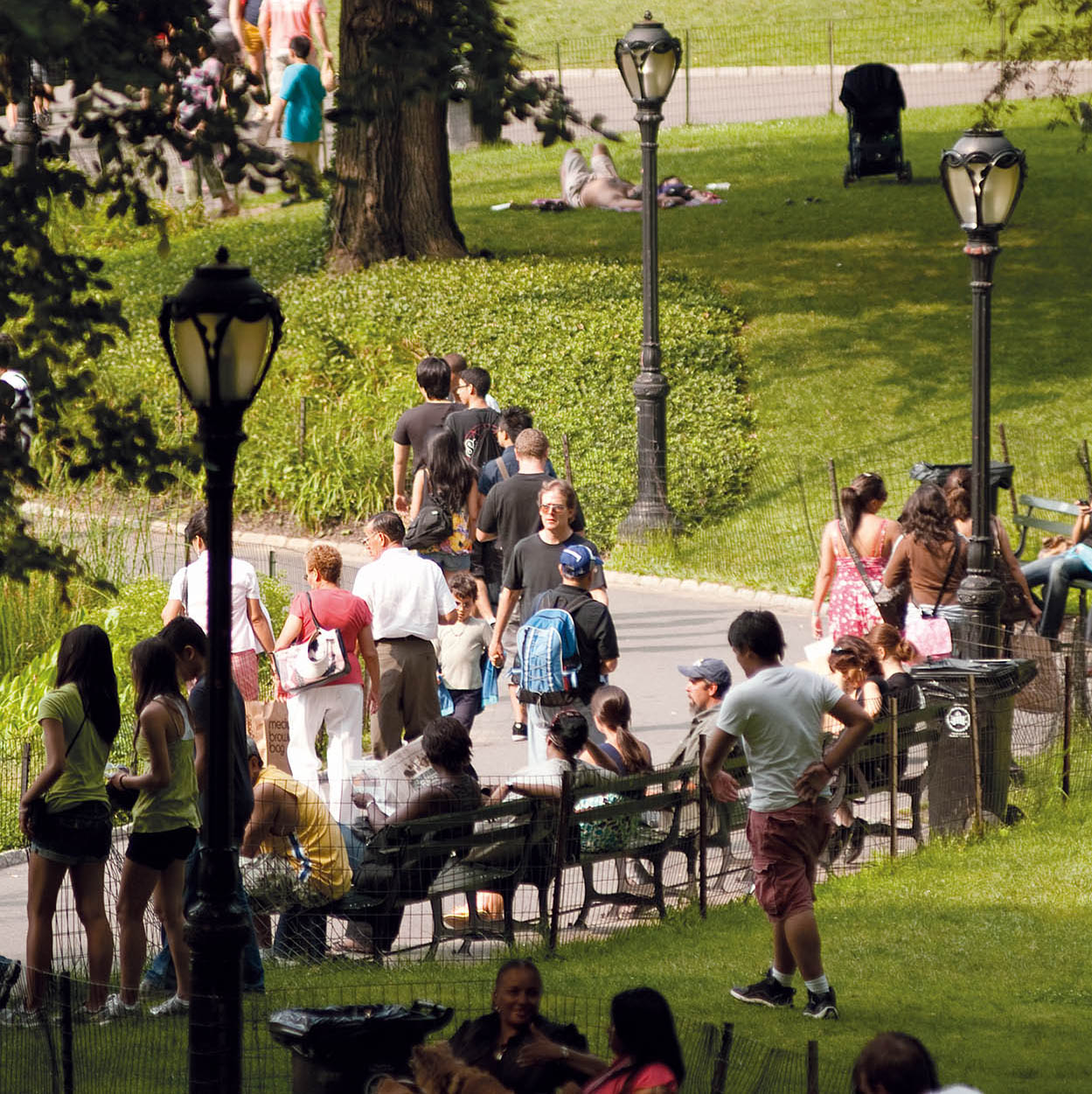
Walkers in the park
Abe Nowitz/Apa Publications
Lincoln Center
The cultural epicenter of the Upper West Side is the Lincoln Center for the Performing Arts › [map], which is bounded by 62nd and 66th streets (on the south and north), Amsterdam (the continuation of Tenth Avenue) on the west, and Columbus (the continuation of Ninth Avenue) on the east. The Center covers an area of 16 acres (7 hectares). The central plaza, a vast esplanade surrounding a fountain, acts as the focal point for the three main buildings. Built in 1960, the whole space is in the midst of a vast modernization program.
In the center is the Metropolitan Opera House (the other ‘Met’), home to the Metropolitan Opera. The opera house was designed by Wallace K. Harrison and completed in 1966. It can hold nearly 4,000 people. Two Chagall murals adorning the central lobby can be seen from the outside. To the left of the Met is the David H. Koch Theater, home of the New York City Ballet and sometimes the American Ballet Theater. Designed by architect Philip Johnson and built in 1964, it has a simple, stately facade complemented by a red-and-gold auditorium studded with crystal; the notoriously bad acoustics were upgraded through the installation of a modern sound system. To the right of the Met, opposite the David H. Koch Theater, is Avery Fisher Hall, completed in 1962, which is primarily used for music concerts.
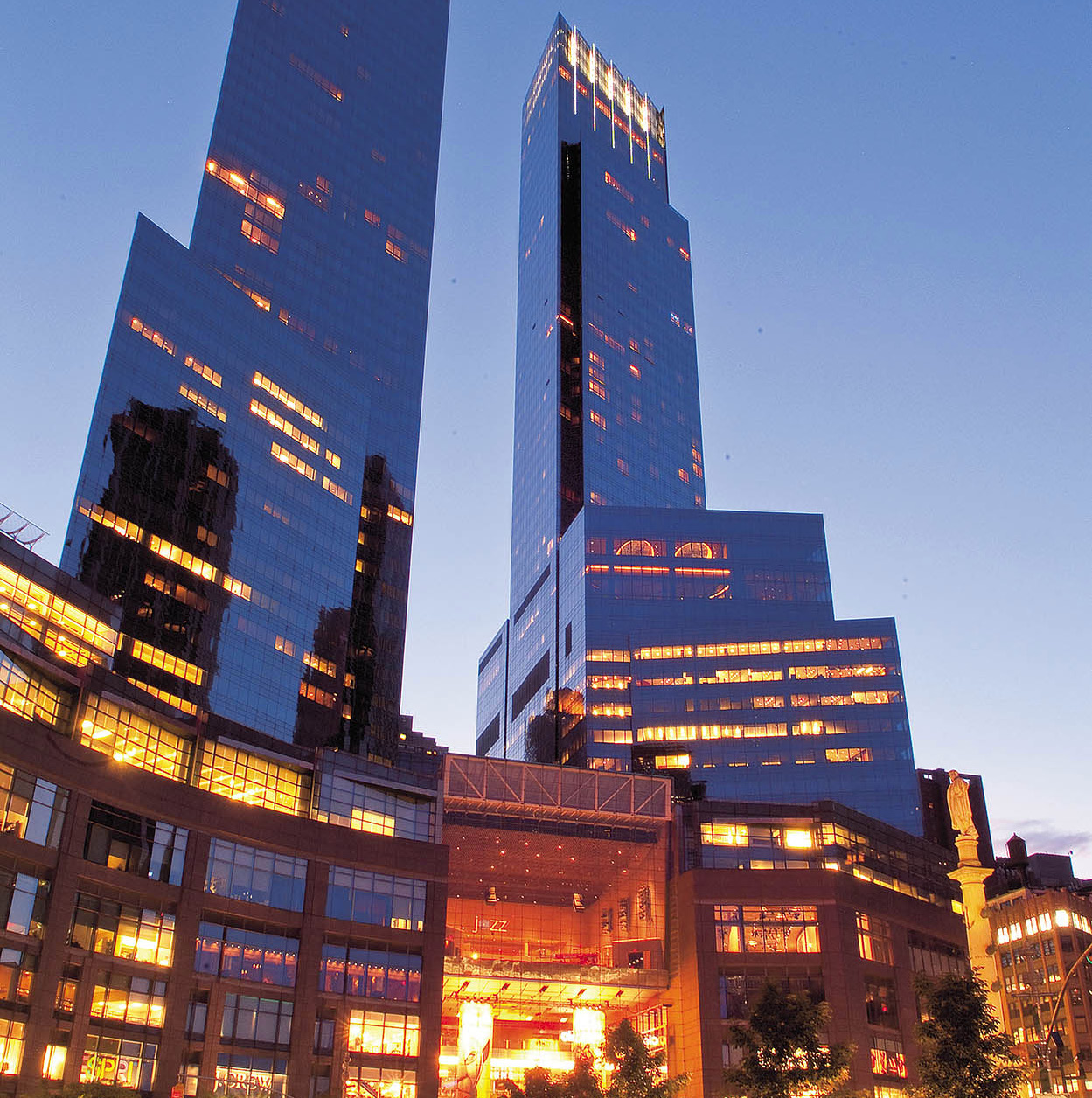
The Time Warner Center at Columbus Circle
Abe Nowitz/Apa Publications
Just behind Avery Fisher Hall, to the right of the Met, you can make out the outline of Vivian Beaumont Theater, the only uptown stage for Broadway plays. Across 65th Street is the Walter Reade Theater, where the Film Society of Lincoln Center screens movies.
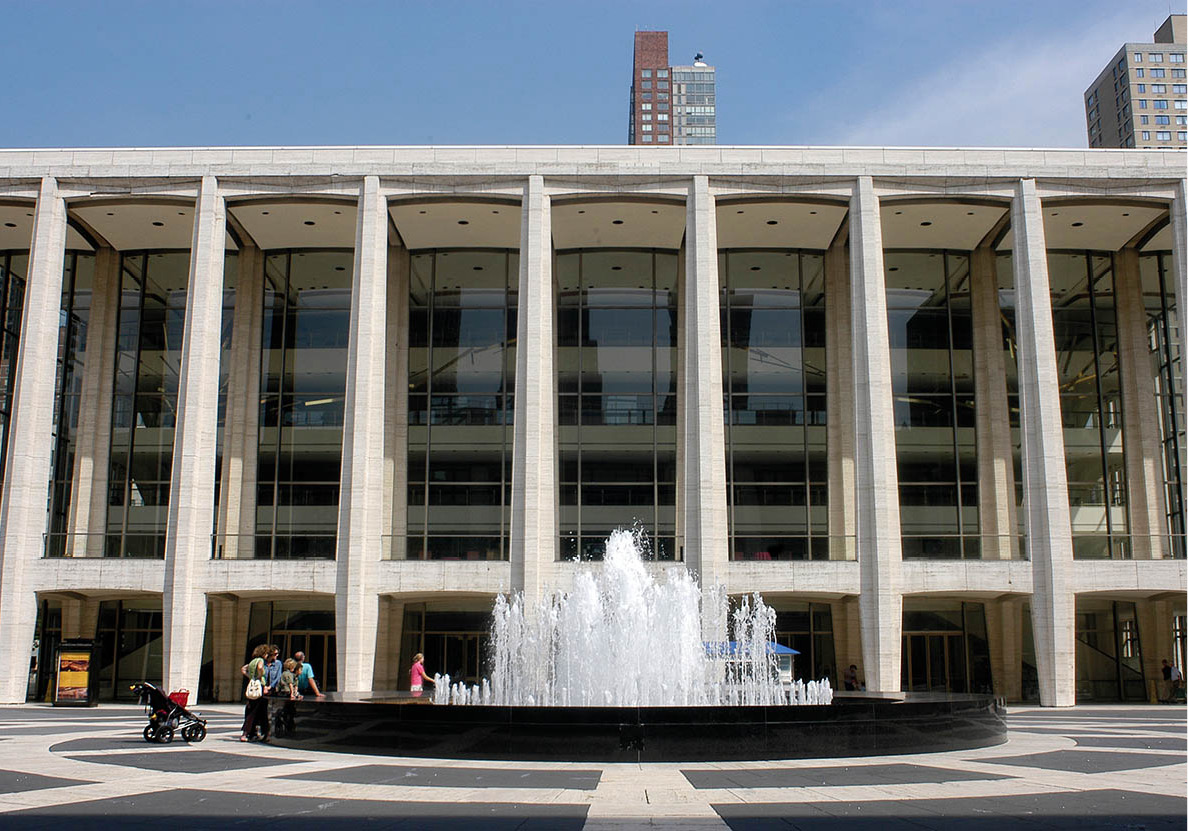
Lincoln Center for the Performing Arts
Britta Jaschinski/Apa Publications
In 2011, the American Folk Art Museum (www.folkartmuseum.org; Tue–Sat noon–7.30pm, Sun noon–6pm; charge) moved its galleries from 53rd Street to 2 Lincoln Square. Celebrating the ‘extraordinary accomplishments of ordinary people,’ the museum has exhibits ranging from 18th- and 19th-century paintings, to quilts and contemporary sculpture.
Farther back, but connected to Lincoln Center by a footbridge over West 65th Street, is the Juilliard School, one of the world’s outstanding music conservatories.
Farther north are several interesting things to see. The Ansonia, at 2109 Broadway (73rd and 74th streets), is a notable Beaux-Arts apartment building. A little farther west, at the corner of 72nd and Central Park West, is the Dakota, which dates to 1884; it has been home to such rich and famous residents as Lauren Bacall and was the setting for the 1968 film Rosemary’s Baby.

The Dakota
Anna Mockford & Nick Bonetti/Apa Publications
A few blocks farther north, between 76th and 77th streets, is the New York Historical Society (www.nyhistory.org; Tue–Sat 10am–6pm, Fri until 8pm, Sun 11am–5pm; charge), the oldest museum in New York (the second-oldest in the US). In addition to documents and artifacts of historical interest, the Society’s collection includes a collection of American fine and decorative arts.
Natural History Museum
The huge building on Central Park West at 79th Street is the American Museum of Natural History fi [map] (daily 10am–5.45pm; charge; www.amnh.org), another of New York’s oldest museums, dating to 1869. Once considered a pretty stuffy place full of old dinosaur bones and dusty taxidermy displays, much of the museum has been reinvented over the past couple of decades and it is now of one of the city’s most popular collections; crowds are drawn to the Hayden Planetarium, the centerpiece of the Frederick Phineas and Sandra Priest Rose Center for Earth and Space. Its Journey to the Stars is an exciting and informative theatrical experience that introduces all ages to the creation of the universe and our solar system.
With tens of millions of specimens and artifacts, the museum is a repository for knowledge about virtually any aspect of earth’s natural history and development. The creaking dioramas are still there and now seem quaint, but the refurbished parts of the museum have the most up-to-the-minute scientific information and wonderful state-of-the-art exhibitions. Examples of this are the Fossil Halls–covering everything from dinosaurs to mammals–and the Hall of Biodiversity, which includes a life-size recreation of a rainforest.

The Hayden Planetarium
Britta Jaschinski/Apa Publications
Don’t miss the full-size model of a blue whale, the Star of India (the largest sapphire that has ever been discovered), and the Barosaurus in the Theodore Roosevelt Rotunda on Central Park West: standing on its rear legs, this long-necked sauropod is the tallest free-standing dinosaur exhibit in the world.
Tours of the collection’s highlights are given regularly throughout the day and there are always a few special exhibitions worth visiting. The museum also has a massive imax theater.
Columbia University Area
Many visitors are surprised to find one of the largest neo-Gothic cathedrals in the world in New York City. The Episcopal Cathedral Church of St John the Divine, at Amsterdam Avenue and 112th Street (www.stjohndivine.org; daily 7.30am–6pm), was begun in 1892 and is yet to be completed. The church is well known for its jazz and choral music series, in addition to its rotating art exhibits.
Beyond the cathedral, at 116th and Broadway, lies the campus of Columbia University. Founded in 1754 as King’s College, Columbia is New York City’s representative in the Ivy League. A private university, its schools of law and journalism and the teacher’s college are widely recognized for their excellence. The School of Journalism is perhaps most famous for administering the Pulitzer Prizes. The campus itself is striking. Right across Broadway stands Barnard College, Columbia University’s affiliated women’s college.

Columbia University
Abe Nowitz/Apa Publications
Close by, in Riverside Park at West 122nd Street, is Grant’s Tomb fl [map], the mausoleum of Ulysses S. Grant. Here lies the commanding General of the Union Army in the Civil War and US President (1869–1877), alongside his wife, Julia Dent Grant. After the war, the general settled in New York City, worked on Wall Street and died here in July 1885. Administered by the National Park Service, the mausoleum, which is the biggest in the US, contains a museum devoted to Grant’s life (daily 9am–5pm, closed Federal holidays; free).
Harlem and North Manhattan
A major African-American cultural, spiritual and business center, Harlem continues to undergo an economic renaissance and rapid gentrification. It is a vital and varied community with rich, poor and middle-income sections, historical landmarks and attractive homes.
A popular way to see Harlem is on one of the hop-on-hop-off double-decker bus tours, or on a specialized tour that often includes lunch and a gospel music performance. Tours that include a Sunday church service are especially popular. For more information, click here.
Harlem begins north of Central Park at 110th Street and extends to 178th Street, bounded on the west by Morningside Heights and Washington Heights and on the north and east by the Harlem River, which connects the Hudson and East rivers. The neighborhood’s commercial center is 125th Street, where you’ll find the historic Apollo Theater (253 West 125th Street; www.apollotheater.org).
Harlem’s churches
Central Harlem is known for its beautiful churches. The Abyssinian Baptist Church at 132 Odell Clark Place (aka West 138th Street) was founded in 1808; its current Harlem home dates to 1923. Also in the area is the Mother AME Zion Church, at 146 West 137th Street, which is the oldest black congregation in New York. St Philip’s Episcopal Church is a striking neo-Gothic building at 204 West 134th Street.
An historic district
Founded by Dutch settlers, Harlem remained a village for a long time. As immigrants moved into the Lower East Side, many middle-class families moved north to Harlem. The influx of black families started around 1900 and reached its height around 1920, when the area became a cultural hub and home to prominent artists and writers associated with the Harlem Renaissance. Historic row houses of this period are preserved in the St Nicholas Historic District between Adam Clayton Powell, Jr. Boulevard and Frederick Douglass Boulevard on 138th and 139th streets.
There are several prominent cultural institutions in the area. The Studio Museum in Harlem ‡ [map] (144 West 125th Street, at Lenox Avenue; www.studiomuseum.org; Thur–Fri noon–9pm, Sat 10am–6pm, Sun noon–6pm; charge), is dedicated to African-American, Caribbean, and contemporary and traditional African art. At Malcolm X Boulevard and 135th Street, the Schomburg Center for Research in Black Culture (Mon and Fri–Sat 10am–6pm, Tue–Thur noon–8pm; free), a branch of the New York Public Library and an art museum, has one of the world’s most important collections covering black history and African-American culture.
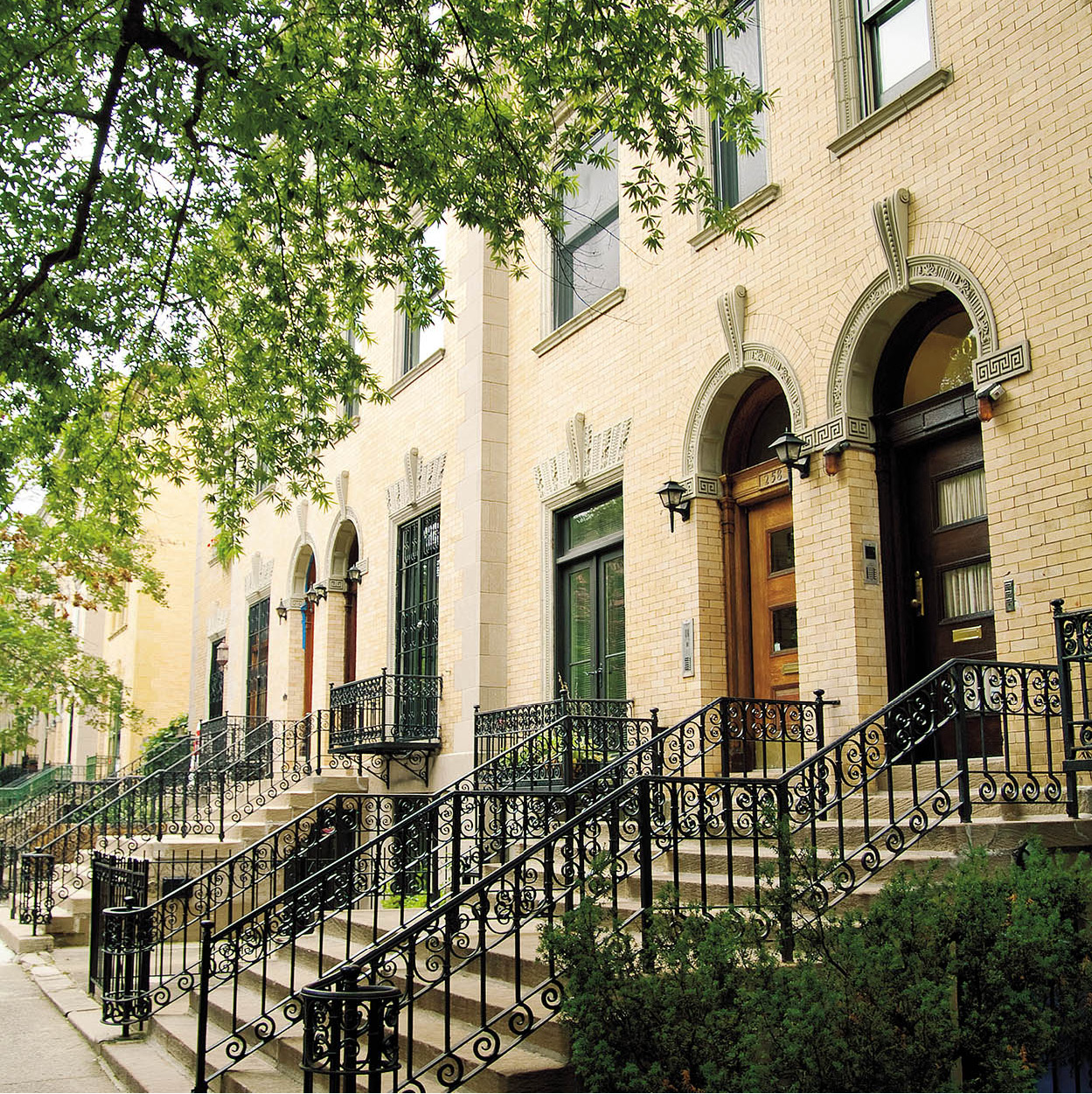
Historic Harlem
Abe Nowitz/Apa Publications
North of Harlem is the Hamilton Grange National Memorial, which was the early 19th-century home of Founding Father Alexander Hamilton. The house was renovated and moved to St Nicholas Park in 2011. The surrounding area, roughly between St Nicholas and Edgecombe avenues and 143rd to 155th streets, was once Hamilton’s farm. It is now known as Hamilton Heights and is home to a historic area that includes the Sugar Hill row houses. The Morris-Jumel Mansion and gardens (1765) at 65 Jumel Terrace (near 162nd street) exhibits period furniture (www. morrisjumel.org; Wed–Sun 10am–4pm; charge).
The 1908 Beaux-Arts style Audubon Terrace complex, on Broadway between 155th and 156th streets, is home to two cultural institutions. The American Academy of Arts and Letters (www.artsandletters.org) has seasonal exhibitions, but is otherwise not open to the public. The Hispanic Society of America has a permanent collection that includes rare books and manuscripts and works by Goya and El Greco. Entrance to the society’s library and museum is free to the public (www.hispanicsociety.org; library Tue–Sat 10am–4.15pm; museum hours change periodically).
Eating in Harlem
If you yearn for something to eat in Harlem, there are many good choices. The place that says Harlem for most people is Sylvia’s (328 Lenox Avenue, at 127th Street, tel: 212-996 0660; www.sylviasrestaurant.com), where you can sample typical South Carolina fare; its Sunday gospel brunch is especially popular. Another popular eatery is Amy Ruth’s (113 West 116th Street, tel: 212-280 8779; www.amyruthsharlem.com).
Washington Heights
Above Harlem, Manhattan narrows to a little sliver made up of Washington Heights and Inwood. Both are primarily residential neighborhoods, but there are a couple of interesting attractions. Washington Heights was long known as a drug-seller’s haven, but it has cleaned up its act and is welcoming a diverse set of new residents who are joining the large Dominican population.
The Cloisters
Beyond Washington Heights is Fort Tryon Park, 66 acres (26 hectares) of landscaped and terraced hills, which begins at 190th Street. From the subway stop (A line), it’s possible to walk through the park to The Cloisters ° [map] (Mar–Oct daily 10am–5.15pm, Nov–Feb daily 10am–4.45pm; charge). Part of the Metropolitan Museum (your admission to the Met also gives you same-day admission here), this branch is devoted to Medieval art and architecture. It is built around parts of several actual cloisters and other medieval structures. The views of the Hudson River from the outdoor terraces are breathtaking, and the gardens provide a great place to sit in reflective solitude.

The Cloisters
Anna Mockford & Nick Bonetti/Apa Publications
Housed within The Cloisters are several genuine masterpieces, including the wood sculpture Enthroned Virgin and Child, a set of ‘nine heroes’ tapestries, a 12th-century carved ivory cross, and the museum’s most popular holding, a set of tapestries depicting the Hunt of the Unicorn.
Not far away is the Dyckman Farmhouse Museum at 4881 Broadway (Fri–Sun 11am–5pm; charge; www.dyckmanfarmhouse.org), the only remaining Dutch colonial farmhouse in Manhattan. If you are in the area, it’s worth a detour.
Other neighborhoods
The Lower East Side
At the turn of the 20th century, the Lower East Side of Manhattan was the most densely populated place in the US, home to around half a million Russian and Eastern European Jewish immigrants. The remnants of the old Jewish neighborhood are located on the northeast side of Chinatown, beyond Hester Street, the site of the Jewish market at the end of the 19th century. Follow Hester Street east and then walk north along Orchard Street, and you’ll see a shadow of the market’s heyday mixed in with hip eateries and new clubs.
In this New World ghetto, the cornerstone of the economy was the ‘needle trade.’ Working conditions and pay were appalling. Those who didn’t toil in the garment factories often worked as peddlers or pushcart vendors, selling produce or cheap clothing in the markets on Hester Street and Orchard Street. The Lower East Side Tenement Museum · [map] at 97 Orchard Street offers an introduction to this area. The 19th-century tenement can be seen by guided tour only, and visitors view restored apartments of immigrant families in the tenement at different historical periods. Tours start from the Visitor Center, across the road at 108 Orchard Street (www.tenement.org; daily 10am–6pm, tour times vary; charge; advance ticket purchase strongly recommended).

The Lower East Side Tenement Museum
Abe Nowitz/Apa Publications
The Bowery
The Bowery is located on the eastern border of the Lower East Side. Once notorious as New York City’s skid row, the Bowery and surrounding neighborhoods are filling up with luxury condominium buildings at a rapid pace. The Whole Foods Market at the corner of Bowery and Houston is always busy and a good place to take a break and grab a snack from a large selection of prepared foods. On the Bowery across from Prince Street is the New Museum, opened in 2007 (www.newmuseum.org; Wed–Sun 11am–6pm, Thur until 9pm; charge). This is the first new art museum constructed from the ground up in downtown Manhattan and the only one in the city devoted exclusively to contemporary art.
Chinatown
Of all the ethnic neighborhoods that were established on New York’s Lower East Side, it is the Chinese enclave that has continued to thrive. The narrow shops sell ivory and jade jewelry, as well as bootleg designer watches and the usual souvenirs; grocers display exotic Chinese produce; and the area’s innumerable restaurants feature a huge range of regional specialties. The earliest Chinese arrivals came here in the 19th century, after the California Gold Rush and the boom of railway construction. These days, the majority of Chinese immigrants actually live in Queens and Brooklyn, but many still work and play in bustling Chinatown, a loosely defined area embracing Canal Street, Chatham Square, and Mott Street. At 215 Centre Street is the Museum of Chinese in America º [map] (www.mocanyc.org; Tue–Sun 11am–6pm, Thur until 9pm; charge). In addition to cultural programs and exhibitions, the museum conducts walking tours of the neighborhood.
Near Chatham Square, at the corner of Division Street and Bowery, stands a 1983 bronze statue of Confucius. South of the square, a few steps down St. James Place, are some of New York’s oldest monuments, barely a dozen tombstones, the remnants of the Shearith Israel Cemetery, founded here in 1656 by New York’s first immigrants, Spanish and Portuguese Jews.
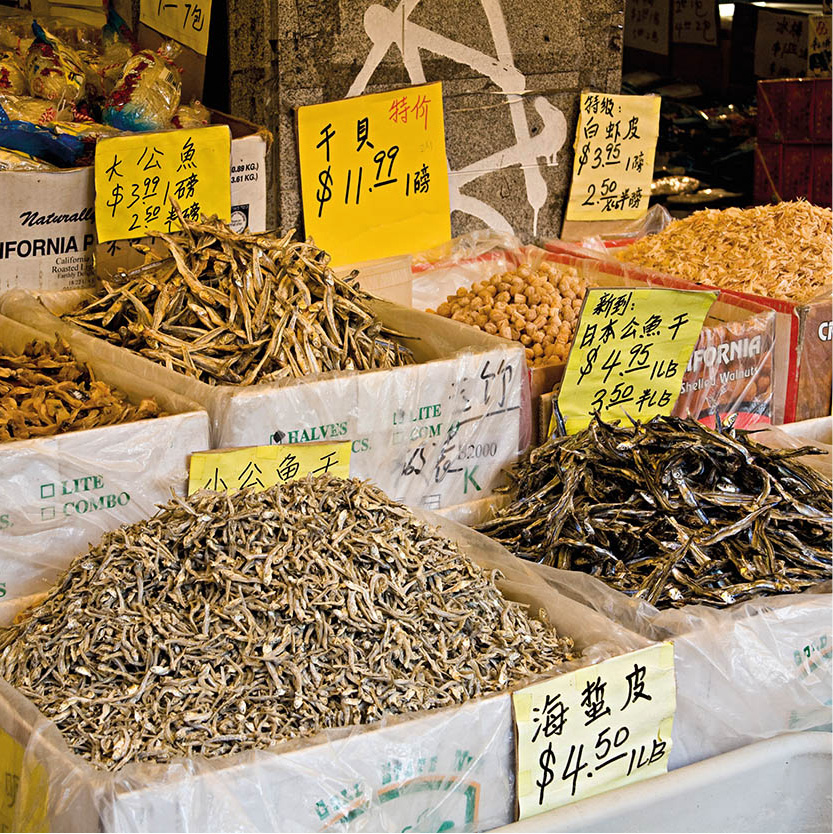
Chinatown dried goods
Richard Nowitz/Apa Publications
Little Italy
‘Little’ is certainly the operative word here, as this area has now been largely subsumed by Chinatown. The stretch of Mulberry Street from Canal to Grand is still home to several Italian restaurants and expensive coffee bars. In the summer, especially on weekends, it is a pleasant place to stroll, buy a souvenir, and have a plate of pasta and a glass of house wine al fresco. There are still some good ‘old world’ bakeries and grocers here, though some of them, too, are now Chinese.
The district is at its liveliest during the ten-day Feast of San Gennaro in early September (for more information, click here). But if you find yourself in the neighborhood, you might want to take a stroll over to the old Police Headquarters at the corner of Centre and Grand streets; this is the building in which Theodore Roosevelt served as New York City’s police commissioner. The inhabitants are now the tenants of the luxury condominiums created in the late 1980s.
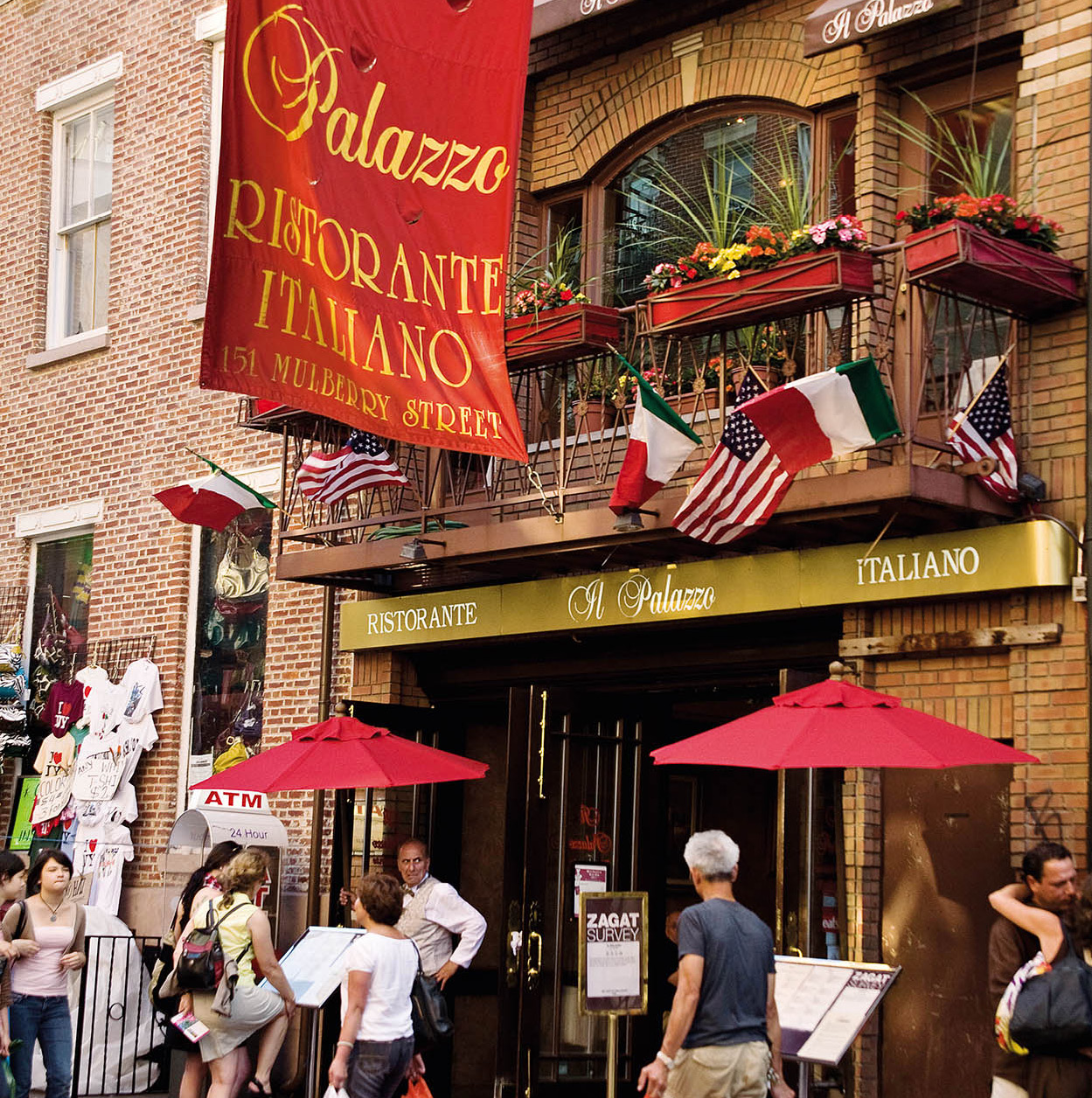
The colors of Little Italy
Richard Nowitz/Apa Publications
SoHo and Tribeca
SoHo (South of Houston) is the area bound by Houston Street, Broadway, Canal Street, and the Hudson River. It has become the Village’s chic southern neighbor, with expensive cafes, restaurants, art galleries, and shops selling the very latest in fashion and housewares.
Its history has followed the pattern of Greenwich Village. Artists who couldn’t afford the rents after the Village’s commercialization moved south to the derelict lofts and warehouse floors of the then industrial district. The most successful were able to install kitchens, bathrooms, and comfortable interiors, while others made do with bare walls and floors for the sake of ample space and light. Now the same lofts sell in the multi-million dollar range.
The main things to do here are to browse in the handful of remaining galleries, stop and relax at the many outdoor cafés and restaurants, and shop. There are plenty of interesting smaller boutiques located on side streets off Broadway, which is home to many big name designers and chain stores. A fun place for kids is the Scholastic Store, 557 Broadway (Mon–Sat 10am–8pm, Sun 11am–6pm). In addition to books, toys, DVDs, videos and games, it has creative displays featuring Clifford The Big Red Dog, Harry Potter, Dora the Explorer, Captain Underpants, The Magic School Bus, and other Scholastic favorites. Events, activities, and storytellings are held nearly every day.
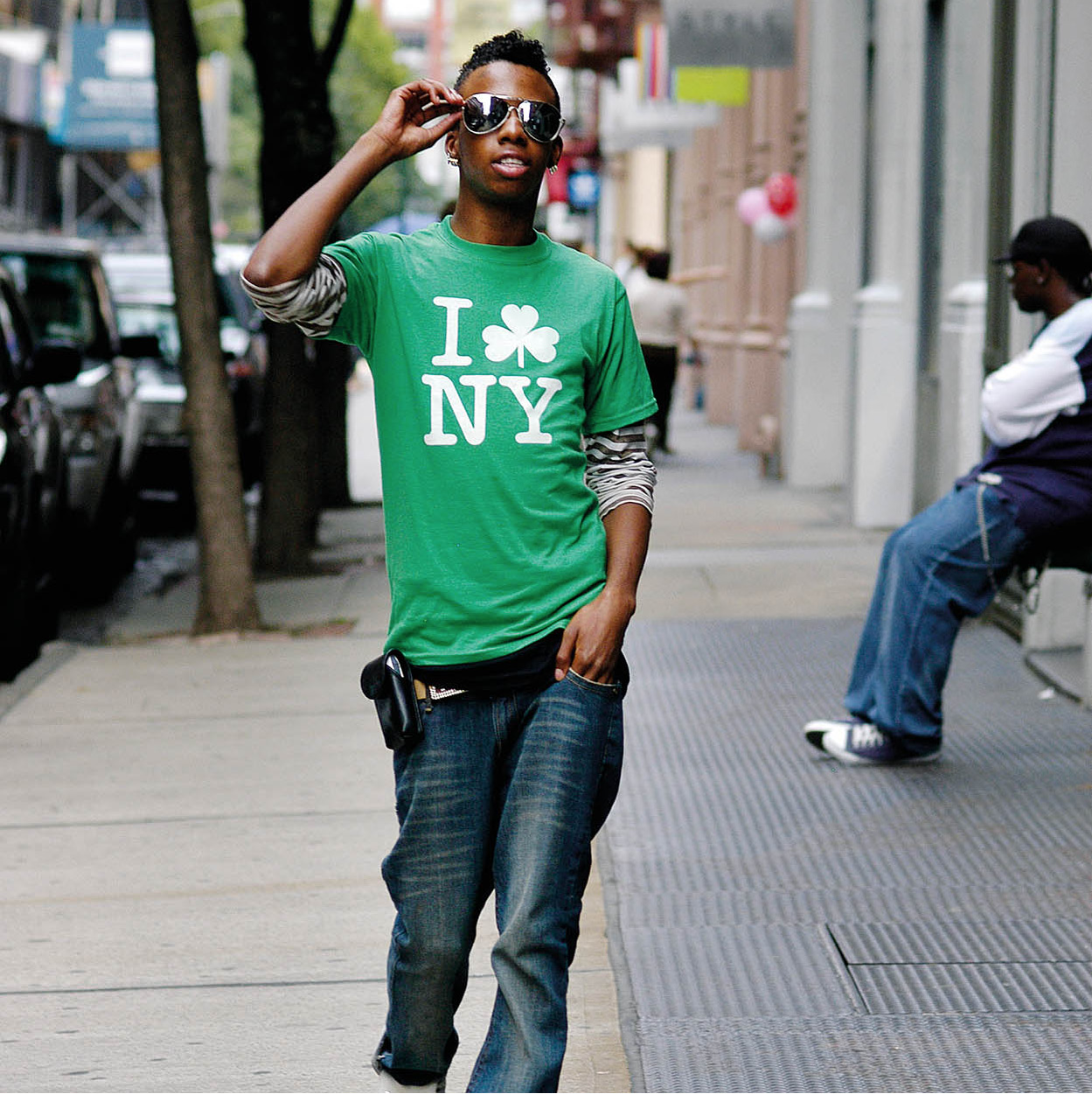
Trendy SoHo
Britta Jaschinski/Apa Publications
West Broadway is the quintessential SoHo street. Here you’ll find the choicest boutiques and galleries. After SoHo became too expensive, the artists moved out, many heading southwest to the derelict warehouses of the Tribeca (Triangle Below Canal) neighborhood, which in its turn has inevitably seen the opening of upscale restaurants and trendy boutiques. As those rents began to soar, many of the artists migrated to Brooklyn and Queens and the art dealers moved to Chelsea.
De Niro’s Tribeca
Tribeca’s expensive loft-style real estate is home to many high-profile New Yorkers. Perhaps the district’s most ardent resident-supporter is actor Robert De Niro. He opened his restaurant Tribeca Grill, which is still going strong, and instituted the Tribeca Film Festival.
Greenwich Village
‘The Village,’ as Greenwich Village is usually called, has been separate, casual, and very different from the rest of the city ever since its beginnings. In colonial times it really was a distinct village called Greenwich, which became a neighborhood of conservative Georgian brick houses and carriage barns in back-alley mews. A few of these houses remain, mostly on Bedford Street and the streets around it, but conservative the Village isn’t. It got its bohemian reputation after World War I, when artists and writers moved here for the area’s cheap lodgings, inexpensive restaurants and speakeasies. Later, the Village became the center for New York’s gay community, which to a large degree has now moved north to Chelsea.
The Village is roughly the area from 14th Street down to Houston and west of Broadway. The area’s heart is Washington Square Park ¡ [map], the de facto campus quad for New York University, which controls much of the real estate east of Sixth Avenue and south of 14th Street to Houston. The park’s famous arch was designed by architect Stanford White and erected in 1889 to mark the centenary of George Washington’s inauguration as president.
Bleecker Street with its craft and curio shops, antique stores, cafés, and tiny restaurants has long been the main shopping strip of the neighborhood. The area’s highest concentration of gay and lesbian businesses and bars is still found on Christopher Street, west of Seventh Avenue South. The Stonewall, at 53 Christopher Street, stands on the site of the original Stonewall Inn, which was the site of the riots in 1969 that led to the modern gay rights movement. You may wish to make at least two trips to the Village; by day to shop and see the sights, and at night to catch the atmosphere, have dinner, and hit one of the jazz clubs or bars.
East Village
A separate community, the East Village extends east from Broadway to Avenue D and the East River. Less affluent than Greenwich Village to the west, this neighborhood has nevertheless fallen victim to plenty of gentrification. Still, you will find eclectic boutiques, restaurants, and shops that can’t afford the other downtown rents. If there is any real bohemian spirit left in Manhattan, it may be here. Walk down St Mark’s Place or Avenue A, the liveliest streets, or people-watch in Tompkins Square.
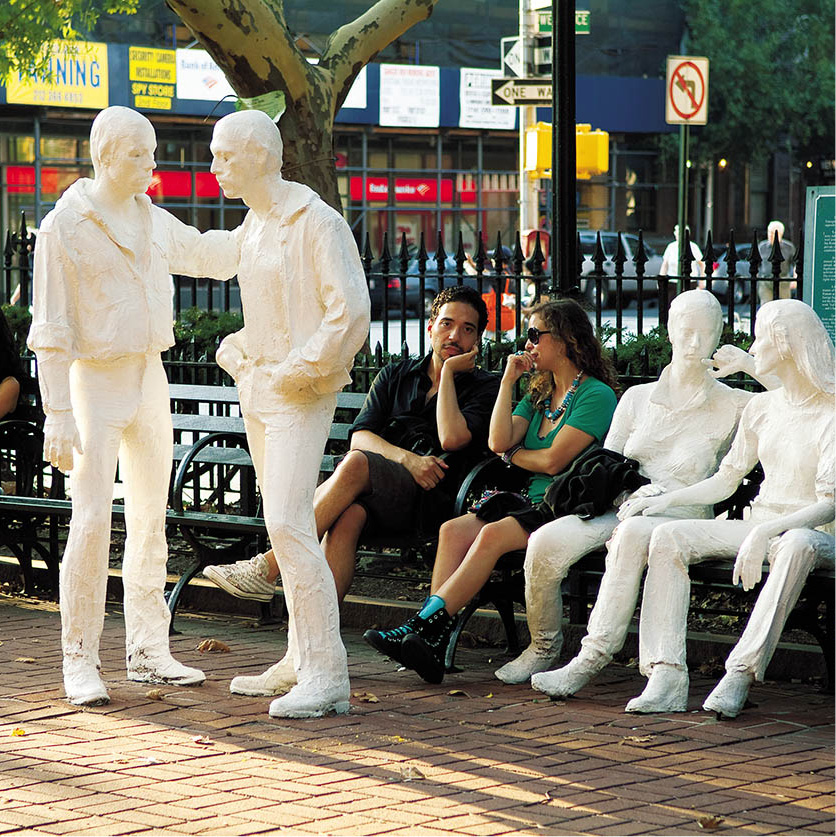
The Gay Liberation statue in Christopher Park
Abe Nowitz/Apa Publications
On Lafayette Street, just to the south of Cooper Square, stands the building that once housed the first public library of New York. Nowadays it is the seat of The Public Theater, which actually contains several theaters and is the host of Shakespeare in the Park. Joe’s Pub, off the main lobby, is a celebrated venue for live music and performance. Nearby is the Great Hall of the Cooper Union, the center of the free university established by Peter Cooper in 1859.
Those interested in historic buildings might stop by St Mark’s-in-the-Bowery, built in 1799 on the very spot where the Stuyvesant family chapel once stood (at 10th Street at Second Avenue). It is now a charming church with some noteworthy stained-glass windows and a spirited congregation, often hosting music or dance performances.
Village voices
Since the Art Nouveau period, Greenwich Village has been one big ‘village of genius’ and home of the artistic avant-garde. The radical paper Masses, whose contributors included Maxim Gorki, Bertrand Russell, and John Reed, had its offices here. In 1914, Gertrude Vanderbilt Whitney opened a gallery and provided a platform for contemporary artists, much of whose work was highly controversial. In 1916, members of the Playwrights’ Theater settled on MacDougal Street and soon achieved fame, Eugene O’Neill among them.
After World War II the Bohemian image of ‘the Village’ persisted. In the 1950s, the beatnik movement flowered (Jack Kerouac and Allen Ginsberg); in the 1960s and early ’70s the area was home to hippies and anti-Vietnam war ac tivists (Abbie Hoffman and Jerry Rubin).
Meatpacking District and Chelsea
The northwest corner of Greenwich Village from West 14th Street to Gansevoort Street is a designated historic district of cobbled streets and warehouses. Home to a meat market during the last century, the area is now awash with trendy boutiques, restaurants, bars, clubs and hotels.
The High Line ™ [map] (www.thehighline.org; daily 7am–11pm, until 8pm in winter), a major public park, opened its first section in 2009 and its final stretch in 2014. The elevated railroad tracks were originally constructed in the 1930s to lift freight trains off the streets of Manhattan. They have been converted into a beautifully landscaped walkway that stretches 1.45 miles (2.3km) from Gaansevoort Street to West 34th Street and 10th Avenue, with multiple entrances and exits.
Housed in a striking new building by architect Renzo Piano, the excellent Whitney Museum of American Art # [map] (http://whitney.org; Wed–Mon 10.30am–6pm, Thu–Sat until 10pm; charge) moved from Museum Mile to the Meatpacking District in May 2015. It was originally founded by Gertrude Vanderbilt Whitney, an artist from one of New York’s wealthiest families. It is one of the few museums that is dedicated solely to American art and that seeks out works from alternative media, such as film and video. By focusing its collection on contemporary American artists (both those of Ms. Whitney’s era and those of today), it has gone a long way toward changing attitudes about the diversity and strength of the country’s art. The permanent collection includes works by such artists as Andy Warhol, Alexander Calder, Georgia O’Keefe, Jackson Pollock, Jasper Johns, and Mark Rothko. Curators continue to build and show works by living artists.
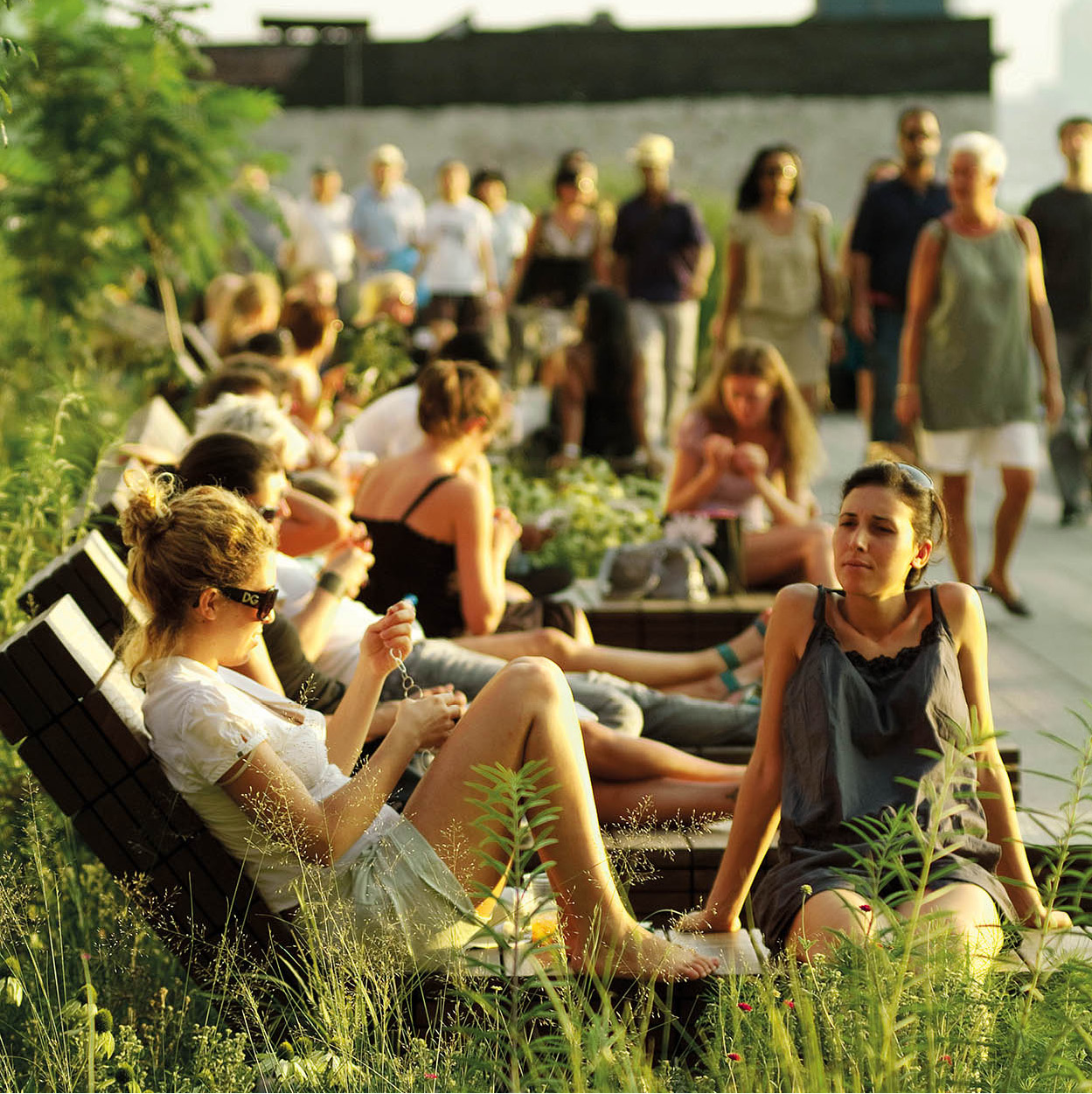
Chilling out on the High Line
Abe Nowitz/Apa Publications
The neighborhood between 14th and 39th streets, west of Sixth Avenue, is thriving after many years of decline. This is one of the trendiest gay neighborhoods in Manhattan. Stroll up Eighth Avenue, where you’ll find gay bars and boutiques, as well as restaurants catering to all types. The Joyce Theater (www.joyce.org), at 19th Street, is one of the city’s main modern dance venues. On 23rd Street, between Seventh and Eighth avenues, sits the famous (and infamous) Chelsea Hotel, with its distinctive wrought iron balconies. The former home to artists, rock stars and assorted sketchy characters, it is currently up for sale. Along the Hudson River, the Chelsea Piers (www.chelseapiers.com) serves up six blocks of sports and entertainment from 17th to 23rd streets.
Seventh Avenue is quieter, but you will still find many restaurants and stores. Loehmann’s, on Seventh Avenue at 16th Street, is a prime source for discounted designer clothing. Sixth Avenue from 18th to 23rd streets was once known as the ‘Ladies Mile.’ For many years, the massive storefronts stood derelict; now they are inhabited by box stores like Old Navy and Bed, Bath, and Beyond.
Chelsea has long superseded SoHo as the place for contemporary art. There are close to 200 galleries on the far west side between Tenth and Twelfth avenues.
Excursions to the outer boroughs
Brooklyn
Brooklyn, which actually has a larger population than Manhattan, is one of America’s largest urban centers. It is well worth a trip over the East River. Brooklyn Heights, the neighborhood closest to Manhattan, is easy to reach. Take subway lines 2 or 3 to Clark Street, or cross the Brooklyn Bridge on foot from the east side of City Hall Park (for more information, click here); the view is unparalleled.
Rising above the East River, the Heights is an attractive area of 19th-century brownstones and picturesque streets, long popular with writers and artists. The Promenade (three blocks down Clark Street from the bridge) is an esplanade with an impressive view, including both the Manhattan skyline and the Statue of Liberty. Late afternoon is a good time to go, when the towers of Lower Manhattan start to glow in the light of the setting sun. At the end of the Promenade, walk south along shady Hicks Street, in a quarter that has changed little since 1860.
If you are interested in subways and how they are run, then a trip to the New York Transit Museum is in order (www.mta.info/museum; Tue–Fri 10am–4pm, Sat–Sun 11am–5pm; charge). Housed in an authentic 1930s subway station at the corner of Boerum Place and Schermerhorn Street, the museum has a great variety of exhibits, many with interactive components. They also have an annex museum in Grand Central Terminal (for more information, click here).
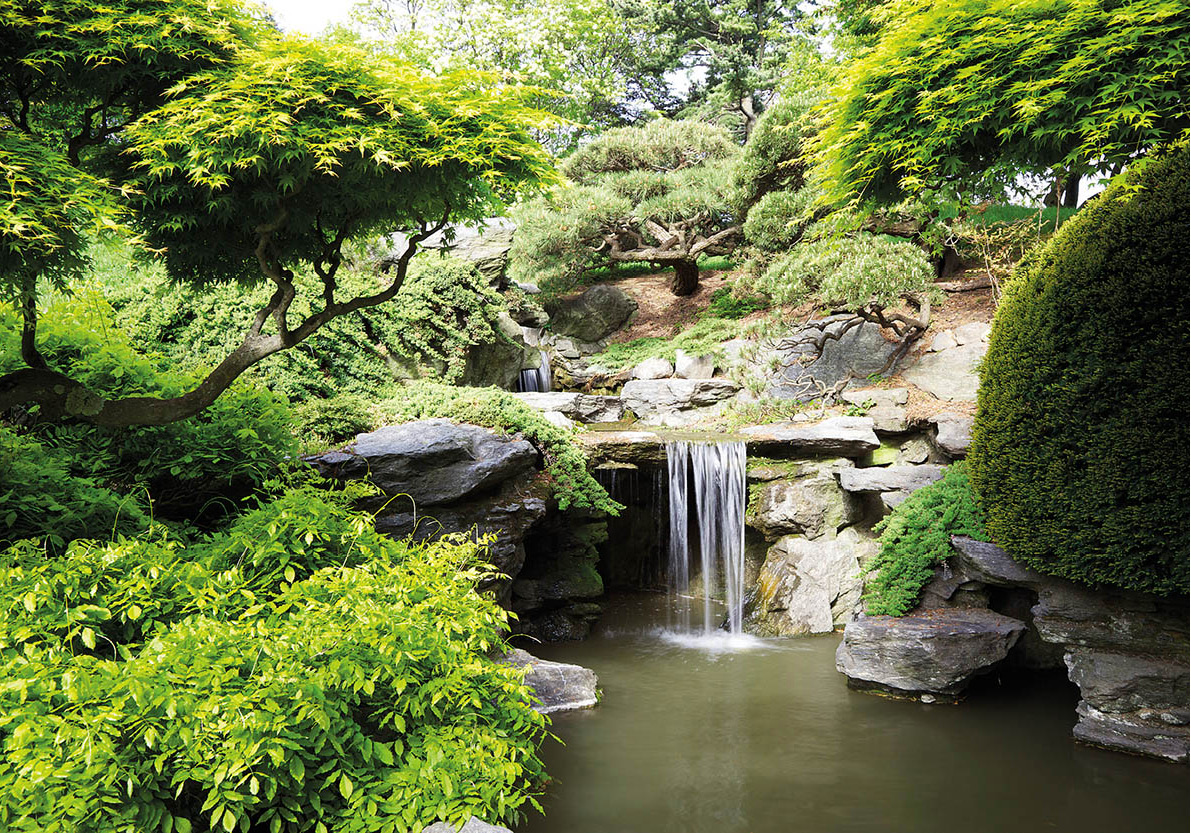
Waterfall in Brooklyn Botanic Garden
iStockphoto
The Brooklyn Museum of Art ¢ [map] (www.brooklynmuseum.org; 200 Eastern Parkway; Wed–Sun 11am–6pm, Thur until 10pm; charge) is the second-largest museum in New York, with exceptional collections of Egyptian, Asian, Persian, and pre-Columbian art. The permanent collection includes more than 1.5 million objects, and the African art collection is one of the largest and most important in the United States. Take the 2 or 3 subway to Eastern Parkway-Brooklyn Museum.
Adjacent to the museum is the Brooklyn Botanic Garden. Not to be confused with the larger New York Botanical Garden in the Bronx, it is nevertheless a peaceful place to stroll. Nearby is Prospect Park, a 526-acre (212-hectare) urban oasis designed by Frederick Law Olmsted and Calvert Vaux (who designed Central Park). A combined visit to the museum, botanic garden, and park is a nice way to spend a day.
The Bronx
For a while now, the Bronx has had a reputation for crime and urban decay. While there are certainly parts of the Bronx where this is still true, visitors who haven’t been here lately will be surprised. Several attractions make it worth a special trip to New York’s only borough on the US mainland.

Siberian tiger at the Bronx Zoo
iStockphoto
One such attraction is the Bronx Zoo ∞ [map] (www.bronxzoo.com; daily 10am–5pm; weekends until 5.30pm, Nov–Mar daily 10am–4.30pm; charge, reduced in winter, suggested donation on Wed). At its most inviting from May through October, when all of the sections are open, the zoo has over 4,000 animals from almost 600 species. At the Congo Gorilla Forest you get to meet the zoo’s gorillas up close. Though they are behind glass, there is still a lot of interaction with the crowd. Other popular exhibits are the Wild Asia monorail (where you can see tigers), JungleWorld, the World of Birds, Children’s Zoo, the 4-D Theater, and, in the summer, the Butterfly Garden. There is an extra fee for entry into most of these special rides and attractions, or you can purchase a Total Experience ticket that will give you access to everything.
To get to the zoo, take the 2 or 5 subway to East Tremont/ West Farms Square. When you exit at street level, walk straight ahead (follow train uptown) for two and a half blocks on Boston Road to the zoo’s Asia gate entrance (Gate A). Alternatively, you can take Metro North from Grand Central to Fordham station, then catch the BX9 bus to the Southern Boulevard Entrance. You can also take the BXM11 Express Bus from Midtown, which runs up Madison Avenue. The Bronx Zoo is the first stop after 99th Street.
Adjacent to the zoo is the 250-acre (100-hectare) New York Botanical Garden (www.nybg.org; Holiday Mon and Tue–Sun 10am–6pm, closes at 5pm in winter; charge). Highlights include specialty gardens, an orchid collection, a 40-acre (16-hectare) uncut, almost virgin forest, and the Enid A. Haupt Conservatory. Children will enjoy learning about plants and nature in the adventure garden. The visitor center includes a shop, café, and visitor orientation area. To get there, take Metro North from Grand Central to the New York Botanical Garden stop.
Yankee tours
Baseball fans may be interested to know that you can take a 60-min tour of Yankee Stadium, in the Bronx, during baseball season (May–September), but this is only permitted on days when the team is not playing at home. You must make an advance ticket reservation through Ticketmaster (tel: 877-469-9849; www.ticketmaster.com) or visit http://mlb.mlb.com.
Queens
The most diverse borough of the five that make up New York, Queens has several attractions of interest. During the silent movie era, Queens was the equivalent of today’s Hollywood – the center of the motion-picture industry – and movies and TV shows are still made at the Kaufman Astoria Studios here. Located in the studio complex, on 35th Avenue at 36th Street in Astoria, the American Museum of the Moving Image (www.movingimage.us; Wed–Thur 10.30am–5pm, Fri 10.30am–8pm, Sat–Sun 11.30am–7pm; charge) celebrates this early movie history and explores the art, technique, and technology of film, television, and digital media, examining their impact on society. To reach the museum, take the R subway to Steinway Street or the N to 36 Ave. (Astoria) and walk.

Long Island City in Queens
iStockphoto
In Long Island City, just across from midtown Manhattan, is the P.S. 1 Contemporary Art Center (22–25 Jackson Avenue at 46th Street; www.ps1.org; Thur–Mon noon–6pm; charge), the largest contemporary art museum in New York and well worth a visit. To get there, take the E subway to Court Square/23rd Street or the 7 to 45th Road/Courthouse Square.
Also in Long Island City is the Noguchi Museum § [map] (9–01 33rd Road, at Vernon Boulevard; www.noguchi.org; Wed–Fri 10am–5pm, Sat–Sun 11am–6pm; charge), created by Japanese-American sculptor Isamu Noguchi to house a comprehensive collection of his works.
